The project team needs to continuously optimize content and activity design, strengthen cross-platform collaboration, and effectively utilize AI and on-chain data analysis to iteratively adjust strategies in real-time.
Author: Cube Labs
1|Web3 Twitter Growth Practice: Three-Stage Content Rhythm and Behavior Guidance Model
Introduction
In the Web3 marketing system, Twitter has never been a channel where "frequent tweeting leads to virality." It is the starting point of the entire user journey and the core battlefield for stimulating user awareness, guiding actions, and solidifying relationships.
For Web3 projects, Twitter serves three key functions:
🔍 Cognitive Shaping: Telling users why you are worth the gas fee;
🎯 Behavior Guidance: Guiding them from following to on-chain interaction;
🤝 Participation Motivation Activation: Activating long-term contributions rather than one-off users.
We advocate that: every tweet is not just content, but a trigger for a behavioral structure. It must possess: ⏱️ Rhythm × 🧱 Layering × 🧭 Guidance
Based on our practical experience building Twitter systems for multiple Web3 projects, this article will break down a complete operational method of "three-stage rhythm × layered content × behavior guidance," with the goal not being exposure, but solidifying valuable users and building a growth loop.
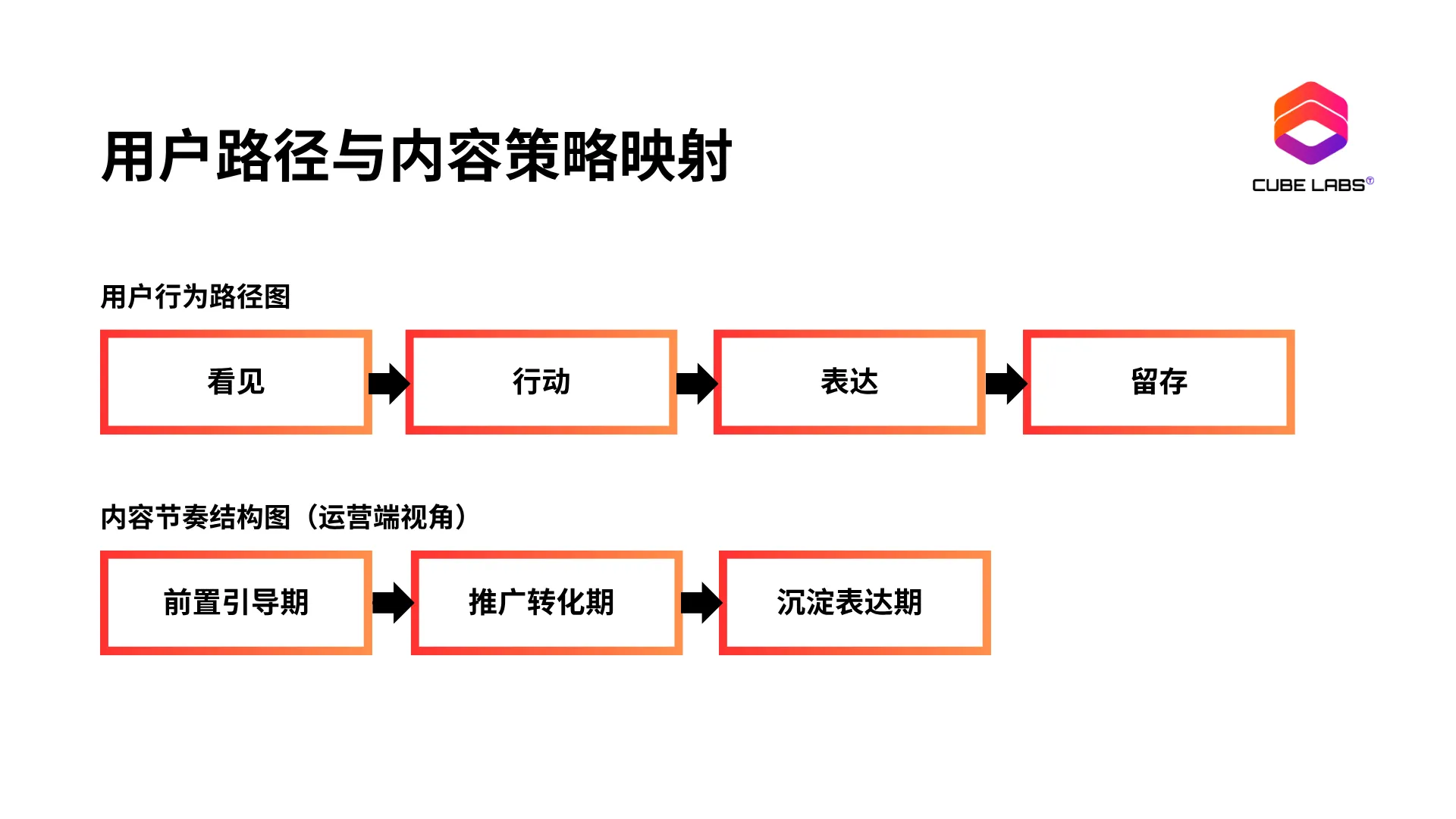
I. What Core Abilities Are Needed to Operate Twitter Well?
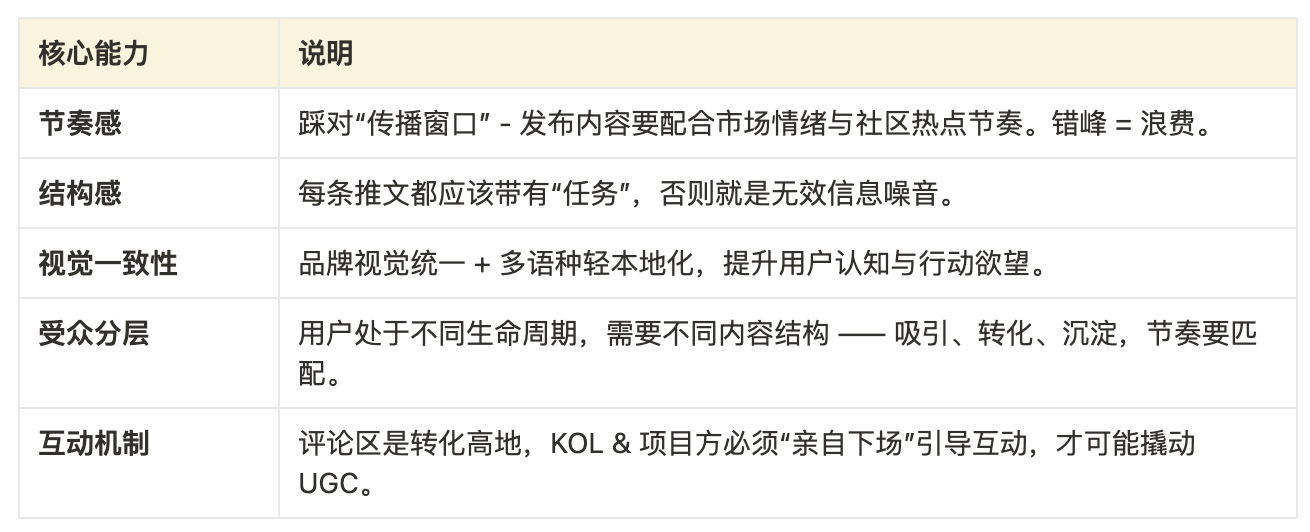
📌 Supplementary Explanation:
“Task”: Refers to guiding users to complete certain actions, such as retweeting, taking screenshots, minting, participating in tests, etc.;
“UGC”: User-generated content, such as sharing images, feedback, comments, and secondary creations, is a sign of community vitality.
In short: you are not just posting content, but planning repeated "user behavior designs."
II. How to Judge Operational Performance? Analysis of Five Core Twitter Metrics
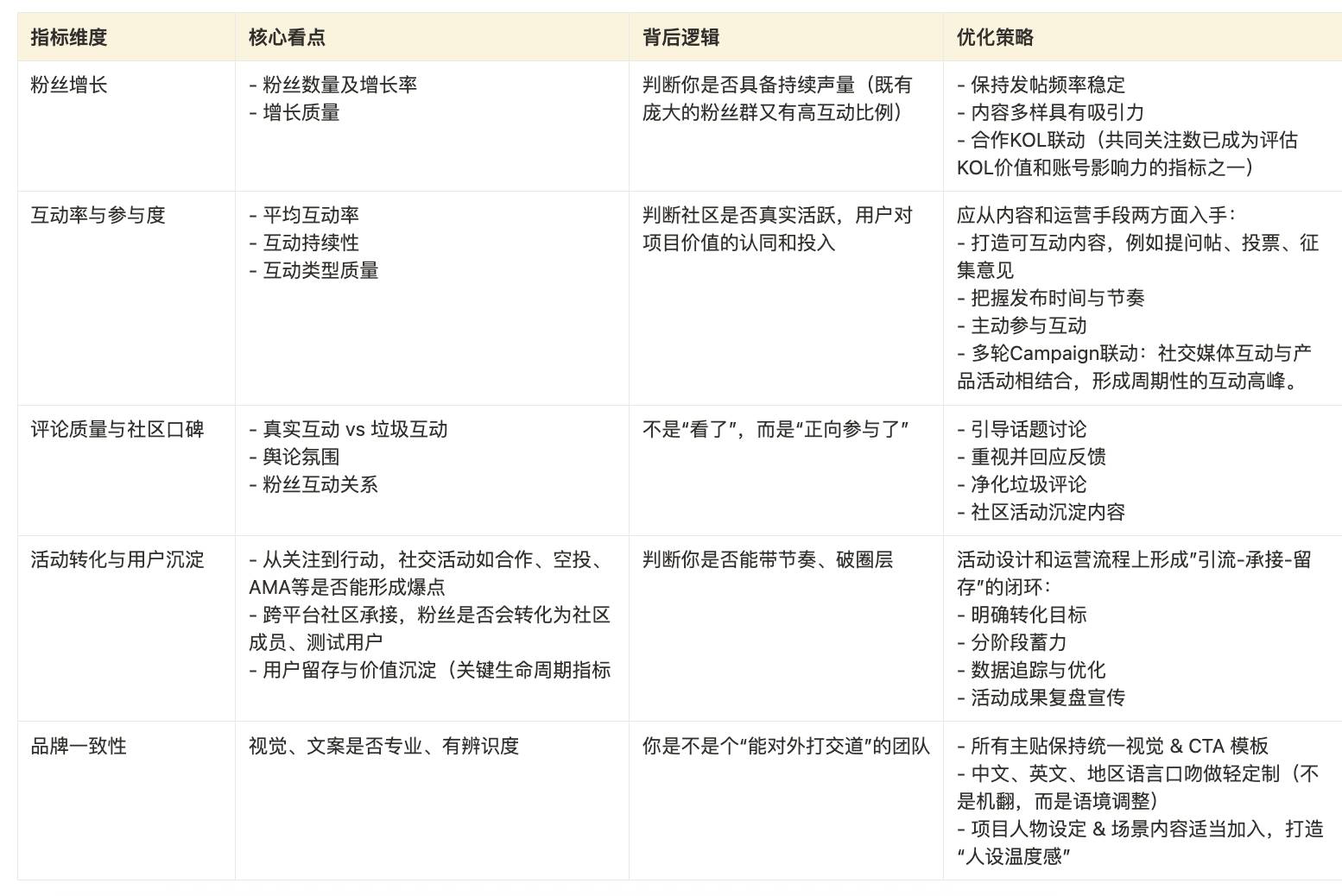 These dimensions not only represent how well Twitter is performing but also serve as underlying indicators of whether you have “collaborative capability”. When planning Twitter operational strategies, project teams can establish a social metrics monitoring table and set warning lines to timely adjust their content strategies. How to view these key metrics? We need to leverage some external tools to observe their real data and trend performance. This article will not elaborate on the specific operation of tools, especially since Twitterscore will be a key tool discussed in detail in another article regarding its principles and usage.
These dimensions not only represent how well Twitter is performing but also serve as underlying indicators of whether you have “collaborative capability”. When planning Twitter operational strategies, project teams can establish a social metrics monitoring table and set warning lines to timely adjust their content strategies. How to view these key metrics? We need to leverage some external tools to observe their real data and trend performance. This article will not elaborate on the specific operation of tools, especially since Twitterscore will be a key tool discussed in detail in another article regarding its principles and usage.
III. User Motivations and Content Matching: It’s Not “Sending to Everyone,” But “What to Say to Whom”
To turn Twitter into a growth engine, the prerequisite is: you need to know why users come and at which stage they are. Web3 users are not just here to "watch the fun"; their behaviors are driven by motivations, thresholds, and limits. You need to address their needs accordingly.
Four Major User Motivations & Content Response Strategies
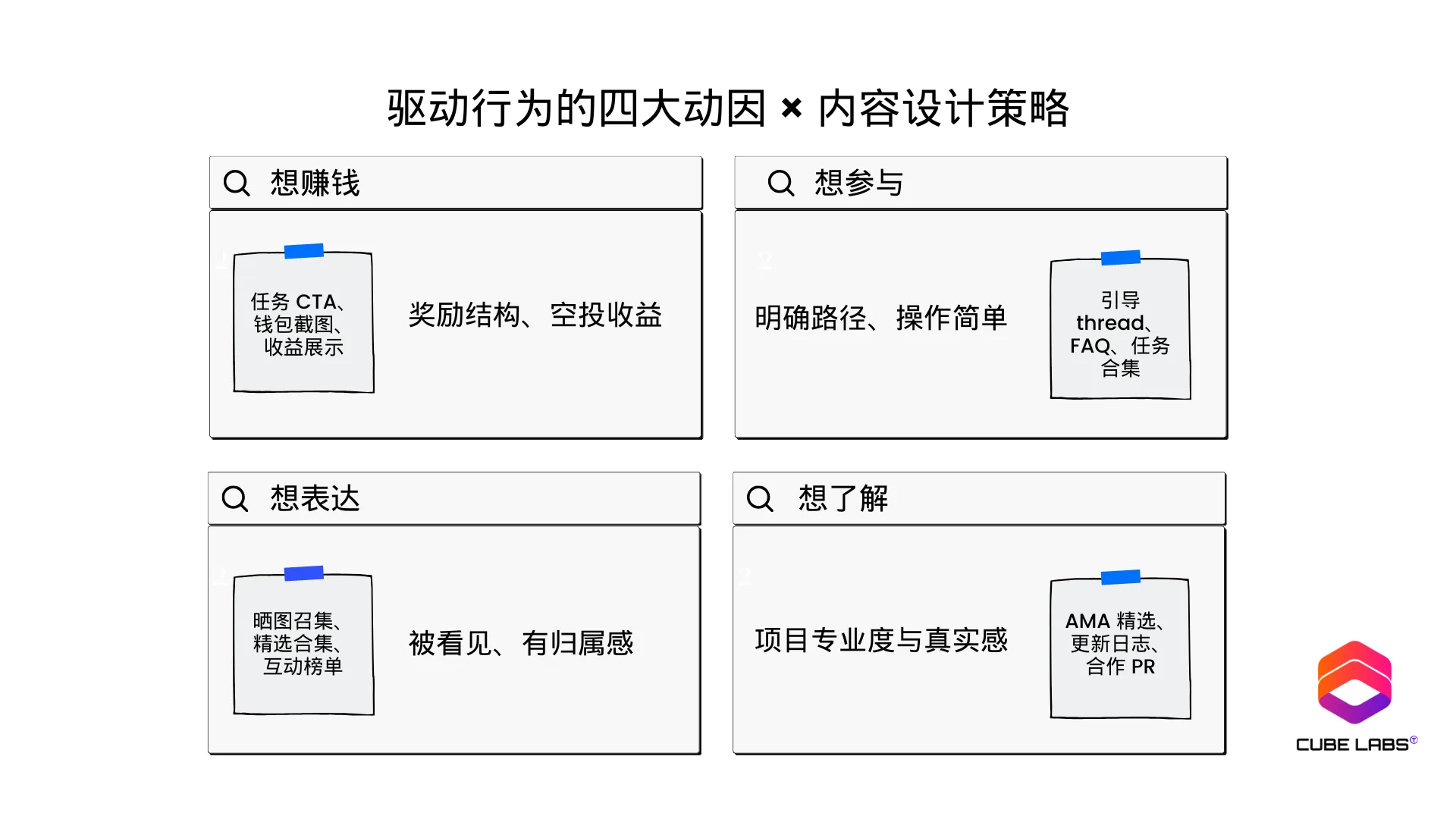
Each tweet should respond to at least one key motivation: “Can I earn?” “How should I participate?” “Are you reliable?” Clearly answering these questions is the switch to activate user actions.
Precise Matching: Different User Asset Levels × Different Guidance Paths
The activity levels of Web3 users vary: not everyone is willing to "hang on-chain," and not everyone will "casually invest." If your content does not accurately correspond to their psychological stages, it will be difficult to truly move or motivate them to act.
Below is a user stratification strategy template based on the GameFi scenario:
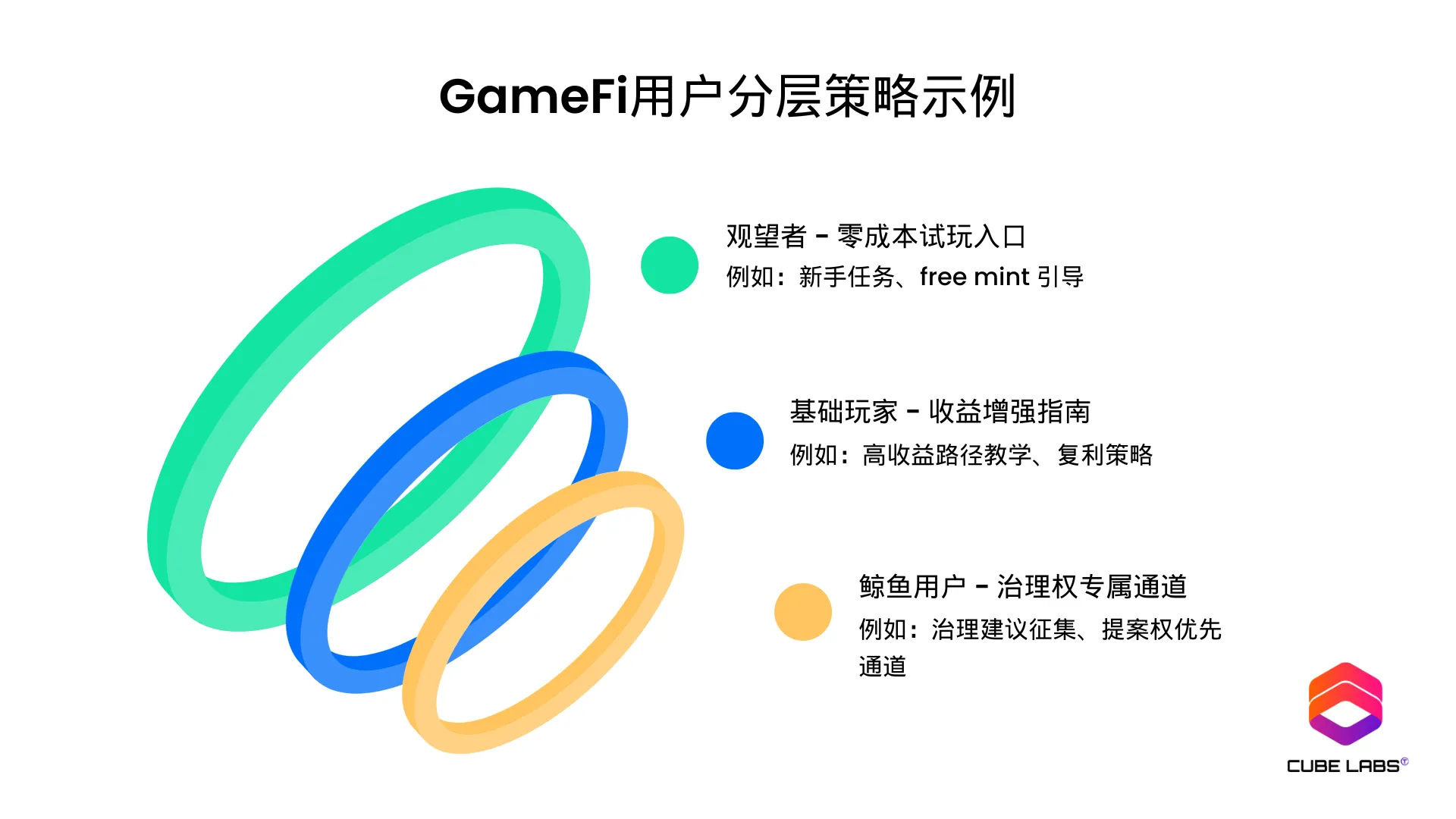
IV. User Rhythm Matching: The Underlying Logic of the Three-Stage Content System
Web3 users have scarce attention, complex motivations, and dispersed paths. Twitter is not just a showcase for content display, but a theater for structurally guiding user behavior. Truly efficient operations aim not to be "seen by more people," but to ensure that the right people take the right actions at the right time. We have summarized a three-stage content strategy model: Rhythm × Content × Behavior, covering the complete path from cold start to solidification.
Key Points of Content Strategy Breakdown
Pre-Guide Phase – Exposure (Awareness)
Increase project visibility to a broad audience, pursuing maximum coverage and initial attention. Content focuses on eye-catching elements and trending topics, with driving traffic as the core goal.
Operational Key Points:
Leverage Hot Topics: Keep up with industry hot topics and popular memes, posting timely comments or topic threads related to the project, using trending hashtags. Utilize community slang and hot events to gain significant views. For example, Pump.fun (a one-click token/meme coin generation platform on the Solana ecosystem) used the community slang "the next big meta" as a topic, sparking discussions. This tweet exploded across the internet in a short time, with approximately 327K views, over 1000 likes, and over 1000 retweets (internal statistics, platform official social media data). The project cleverly captured the popular phrase, creating suspense with a short question to guide user interaction. Coupled with the background of Pump.fun having issued over 11 million tokens and accumulated a fund pool market value of over $4.5 billion, this tweet quickly spread across major discussion boards in the crypto community, increasing brand awareness and platform usage.
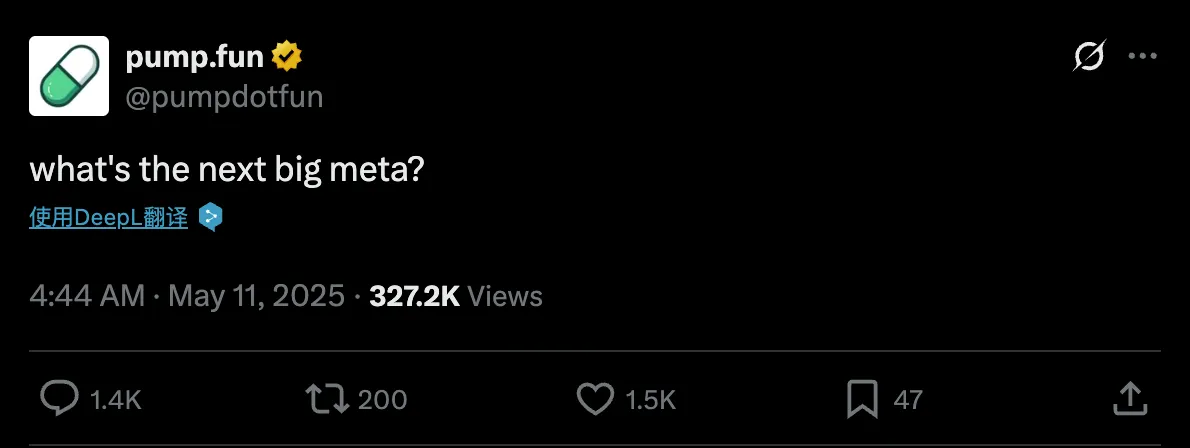
Broad Interaction: In the early stages with few fans, actively participate in discussions with influencers to capture traffic. At the same time, interact more with potential users: like relevant posts daily, retweet quality content, and reply to all received comments to enhance presence in a larger circle. This stage aims to let as many people "see you" as possible, thus making every effort to expand content reach.
Eye-Catching Visual Elements: Use images, videos, and other rich media to enhance user retention. Web3 projects can share product screenshots, data charts, or fun memes to increase content appeal. For example, Azuki (a well-known NFT project) is adept at attaching exquisite anime illustrations or short animations, making its tweets stand out in the vast information flow, attracting numerous retweets and discussions.
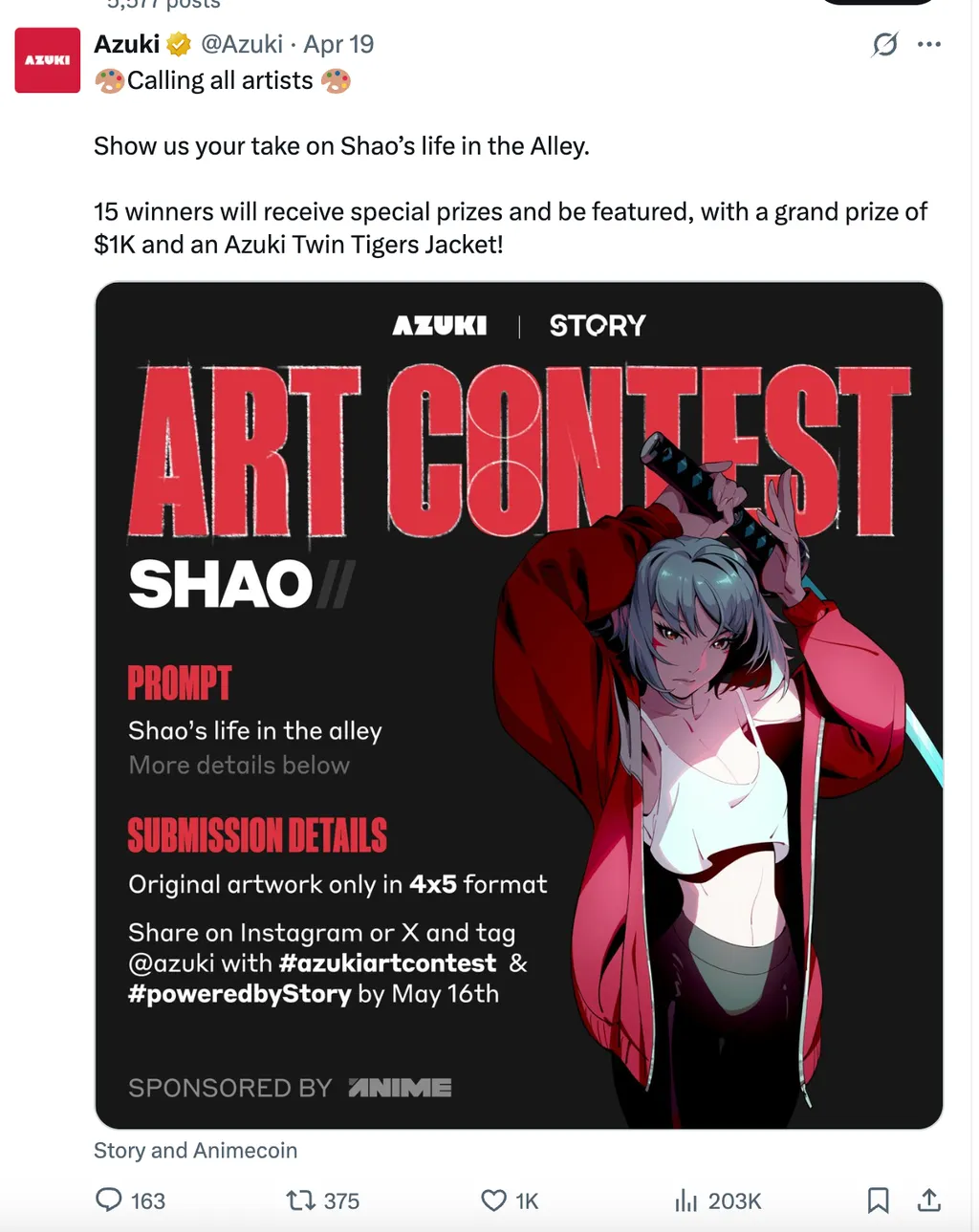
High-Frequency Content Output: Maintain a stable and relatively high posting frequency to combat algorithmic forgetfulness. A new account that only posts once a week will struggle to build momentum; conversely, high-frequency activity is more likely to be recommended by algorithms to more people. In practice, consider at least 1-2 original tweets daily + several interactive retweets. Early on, exchange "quantity" for "quality" accumulation, and the timing of content releases should match the active hours of target users, such as choosing peak times in the afternoon UTC for the European and American markets.
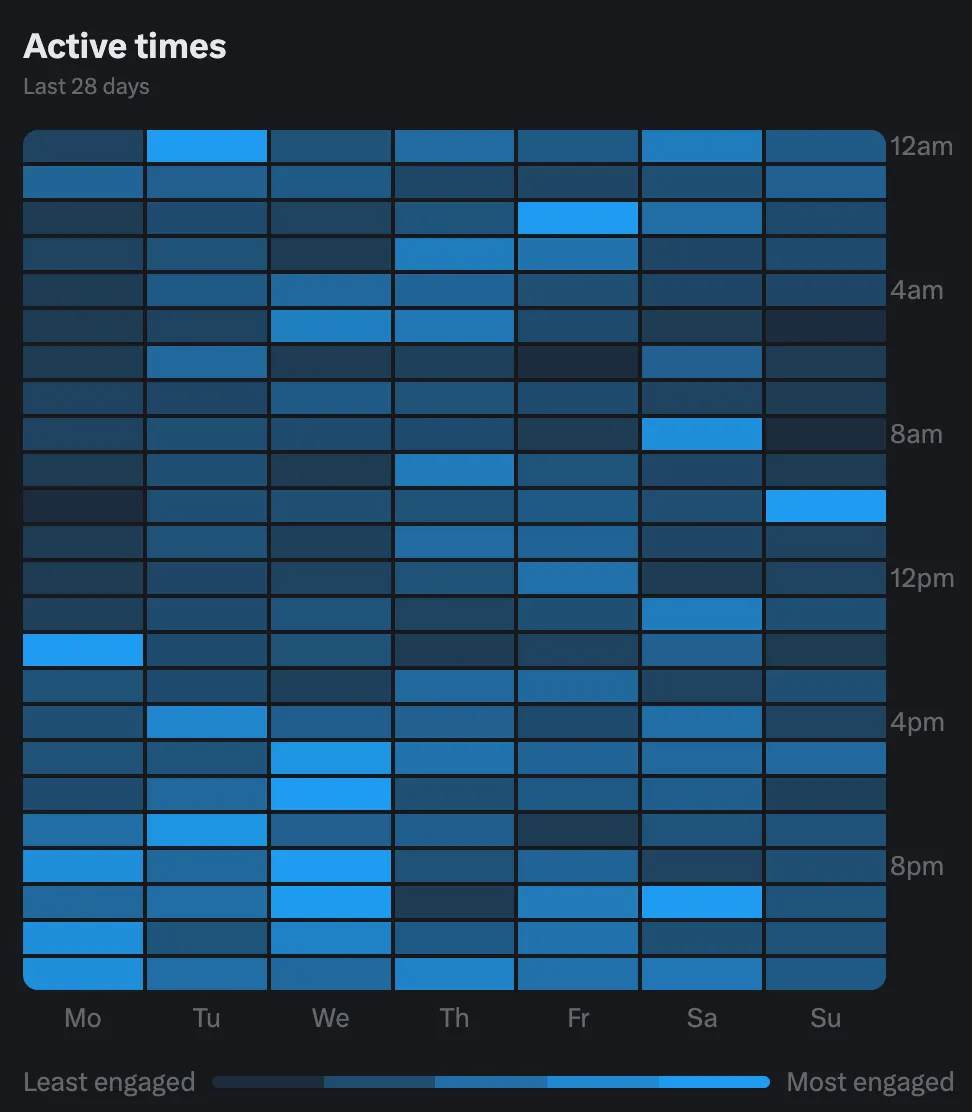
Illustration: Active hours of Twitter users for strategy-based GameFi projects
Promotion Conversion Phase – Interaction (Engagement/Activation)
After gaining basic exposure, enter the conversion guidance and interaction cultivation phase. The goal is to turn potential followers into actual followers and gradually build trust and stickiness. The content strategy emphasizes value output and two-way communication to increase participation and promote actions as core objectives.
Operational Key Points:
In-Depth Value Content: Produce content that provides actual value to target users, enhancing their motivation to follow. For example, posting educational tutorials or detailed project analysis threads can satisfy the audience's thirst for knowledge. The team behind Curious Addys (an NFT project) once published a tweet thread explaining the smart contract refund mechanism, garnering over 1000 likes, far exceeding the usual response to single tweets. It is speculated that Twitter's algorithm also favors content that keeps users engaged for longer, helping to gain more recommendations. In content presentation, the beginning should directly highlight key points to grab attention, with clear structure in the body and minimal use of overly obscure terminology to lower reading barriers. By continuously outputting valuable content, turn passersby into fans.
Interactive Activities: Design content that can stimulate fan participation, such as chain topics, AMA Q&A sessions, polls, and quizzes, to cultivate community interaction habits. Twitter's Spaces is a great tool for this, allowing regular AMAs where team members can interact with users in real-time. For example, hold a project progress sharing session every two weeks, where listeners can ask questions; or initiate polls to gather community opinions on product features. Such interactions not only increase user stickiness but also make them feel valued, making them more willing to follow the project long-term.
Emphasizing User Behavior: Clearly call to action (CTA) in tweets to convert exposure into actual results. Depending on the project attributes, CTAs can invite users to visit the official website, subscribe to emails, join Discord/Telegram groups, or participate in testnet experiences. The key is to keep the statements concise and powerful, highlighting the benefits of taking action. For example, the Layer2 project Base emphasizes guiding users "to experience various dApps on Base." Statistics show that its tweets often directly inform users about "what they can do" on the Base chain, such as minting NFTs and participating in mini-games. This continuous behavior guidance led to an increase in daily active users from 325,000 to 1.2 million within three months, with most users remaining after the event ended. Similarly, other projects can attach operational links to tutorial posts or specify participation steps in event posts to guide the audience to complete target behaviors (such as registration, minting, etc.), transforming attention into real user growth.
Building Brand Trust: Appropriately share the team stories and milestones behind the project to enhance credibility. While ensuring that the main content is valuable, interspersing some "behind-the-scenes" details can help users feel the warmth of the project. For example, posting photos to celebrate 100 days since the testnet launch or sharing insights from the founder debugging contracts late at night. These everyday details help establish an emotional connection, making fans trust the project's long-term development more. Especially in the Web3 field, anonymous teams often leave users feeling insecure; demonstrating a certain degree of authenticity and transparency can solidify trust. As seasoned practitioners say, after a long bear market, users increasingly crave trust, and a "genuine and straightforward persona" is more likely to gain recognition. Therefore, in the interaction phase, in addition to producing professional content, it is also essential to shape a reliable brand persona.
The content formula for the interaction phase is suggested as: 40% value content + 30% project updates + 20% interactive topics + 10% light-hearted fun
Retention Phase – Solidification (Retention/Loyalty)
The ultimate goal is to solidify existing fans and users into loyal supporters, becoming long-term advocates and the ecological foundation of the project. This phase focuses on enhancing user loyalty and sense of belonging, preventing traffic loss and forming a sustainable growth private traffic pool. The content strategy emphasizes refined operations and relationship maintenance, with community cohesion as the core.
Operational Key Points:
Strengthen Community Belonging: Guide users through Twitter to deeper community platforms (such as Discord, Telegram) and continuously provide exclusive value. For example, regularly publish the latest community updates or exciting discussions and invite fans to participate; for active fans, send community invitations or badge NFTs via private messages to enhance their sense of honor. At the same time, showcase fan creations (such as illustrations, suggestions, etc.) on Twitter, publicly recognize the contributions of loyal users, and encourage more people to participate in interactions and align with the core.
Sustained Quality Interaction: During the retention phase, it is still necessary to maintain the rhythm of content output, but the frequency can be slightly reduced while the quality should be higher. Refine content to reward long-term attention from old fans, such as in-depth research reports, roadmap interpretations, and detailed live streams of major features. At the same time, closely monitor fan feedback: reply to all comments as much as possible, promptly answer private inquiries, and publicly thank and respond to important opinions. This ongoing heartfelt operation will make users perceive the project's sincerity and dedication. "Users are not foolish; they can tell at a glance whether the project team is sincere" — when fans genuinely feel valued, their likelihood of retention significantly increases, and they are more willing to actively share and promote the project. It is important to maintain the continuity of the rhythm to avoid content gaps that could lead to user loss after acquiring a batch of users.
Data-Driven Optimization: The retention phase relies more on data to optimize operations. Focus on observing: ① Retention rate (whether there is frequent follower loss); ② Interaction quality (the proportion of high-quality interactions such as retweets and long comments); ③ Conversion effectiveness (actual conversion from Twitter to registration/joining groups); ④ Public sentiment trends (whether brand mentions are positive). KPIs can be set, such as "adding X quality followers monthly and converting Y into the community," with regular reviews to continuously optimize strategies.
Incentivizing Brand Advocacy: Transform core fans into brand advocates. For example, plan hashtag challenges encouraging old fans to share experiences or screenshots related to the project, offering official retweets and rewards; select "Community Stars" and publicly recognize them to encourage more user participation. At the same time, guide these loyal fans to join DAO or contributor programs to participate in project co-construction. When users transition from bystanders to builders, true solidification and conversion are achieved.
Additional Suggestions: Three Elements of Tweet Content
Clarifying User Positioning
Each tweet needs to be targeted based on the behavioral characteristics and content preferences of the main audience region, rather than simply using a one-size-fits-all approach.
For example, in strategy-based GameFi projects: Vietnamese users prefer visuals that convey a "ranking sense" and incentive rankings, eager to take screenshots and showcase results; Japanese and Korean users tend to favor visually striking and well-designed content; English-speaking users generally focus on actual benefits, with conversion intentions more concentrated on staking, NFT rewards, etc.
Such positioning allows for more targeted content deployment.
Systematizing Topic Structure
We do not simply stack popular hashtags but use a combination of “#ecological tags + #project core terms + optional task platform” to enhance content discoverability and contextual coherence.
For example:
For tasks conducted on the Base chain, prioritize using #Base to strengthen ecological belonging;
If the task platform itself has brand effects (like QuestN), consider adding #QuestN to enhance platform exposure;
However, for certain platforms or stages, we will consciously avoid platform tags to prevent user paths from being diverted to other projects.
The core of topic structure is not about "comprehensive coverage," but about controlling user attention focus and maintaining semantic consistency and clarity.
Standardizing Image and Text Structure (Recommendations)
Unified image style (brand feel)
Text structure = Question → Marketing Setting → Behavior Guidance
Attach CTA links, with clear descriptions (rewards/deadlines should not be vague)
Expansion: How to Create Viral Tweets?
Generally speaking, a viral tweet (content that spreads virally) often possesses the following elements:
Hits on hot topics or pain points: Either closely relates to current hot events with insights or provides solutions to users' actual pain points.
Eye-catching opening: The first few characters of a tweet determine whether users will expand to read more. Viral tweets often start with suspense, shock, or questions to spark curiosity; or directly present conclusions/benefits to attract user attention.
Content has practical or emotional value: Either provides valuable knowledge/benefits or resonates emotionally (humor also counts as emotional resonance). Pure advertising is unlikely to go viral; users are more willing to share content that is useful or interesting to others. So when writing, ask yourself, "What is the motivation for a stranger to retweet this?" If the answer is unclear, the content needs refinement. For example, a security scam prevention guide summarized by an exchange was widely retweeted and saved due to its reference value for all users; similarly, a project using humorous comics to depict industry chaos sparked laughter while also conveying brand attitude, achieving viral spread.
Skillfully Using Algorithm Preferences: Utilize known platform recommendation mechanisms to amplify dissemination. As mentioned earlier, long threads increase user engagement time, which helps trigger secondary algorithm recommendations; for instance, appropriately using 1-2 popular topic hashtags can allow users under related topics to see the content. Additionally, guiding interactions can garner more exposure, as algorithms favor "high-value interactions," namely shares and comments. These engagement behaviors can indeed enhance tweet weight to some extent. However, be cautious to avoid excessive inducement (like frequent lottery tactics) to prevent user aversion or being flagged as low quality by algorithms.
Timing and Frequency: The emergence of viral content is also related to the timing of publication and the long-term tone of the account. Publishing during the most active periods for the target audience can yield better results. Furthermore, maintaining a certain level of quality and verticality in account content over the long term can cultivate platform trust.
In short, a viral tweet = the right content + the right time + good account accumulation, resulting from their combined effects. Each stage is not completed by a single tweet but relies on a closed loop composed of "content – interaction – feedback." We suggest viewing these three segments as a coherent path:
Pre-Guide Phase = Open the Door → Conversion Phase = Sit Down and Chat → Retention Phase = Stay for Dinner
If you are planning content promotion for a Web3 project, consider using this model to evaluate your content rhythm. As long as you understand the correspondence between user states, content preferences, and target behaviors, the ROI of the content can potentially shift from "buzz" to "growth."
V. Practical Verification: Is the Content Rhythm Model Really Effective?
We have previously broken down the complete three-stage content structure model (Pre-Guide → Promotion Conversion → Retention Expression), so:
Does it work in real projects? Is it universally applicable in the industry? The answer is affirmative.
Here are the practical results from a GameFi project:
Structured Content + User Behavior Guidance → High Conversion Explosion
We deployed a complete Twitter content rhythm in this project, covering:
Visually unified task main posts + warm-up posts
KOL ignition diffusion + multilingual deployment
Clearly guided CTA content
Community expression interactions
The results are as follows:

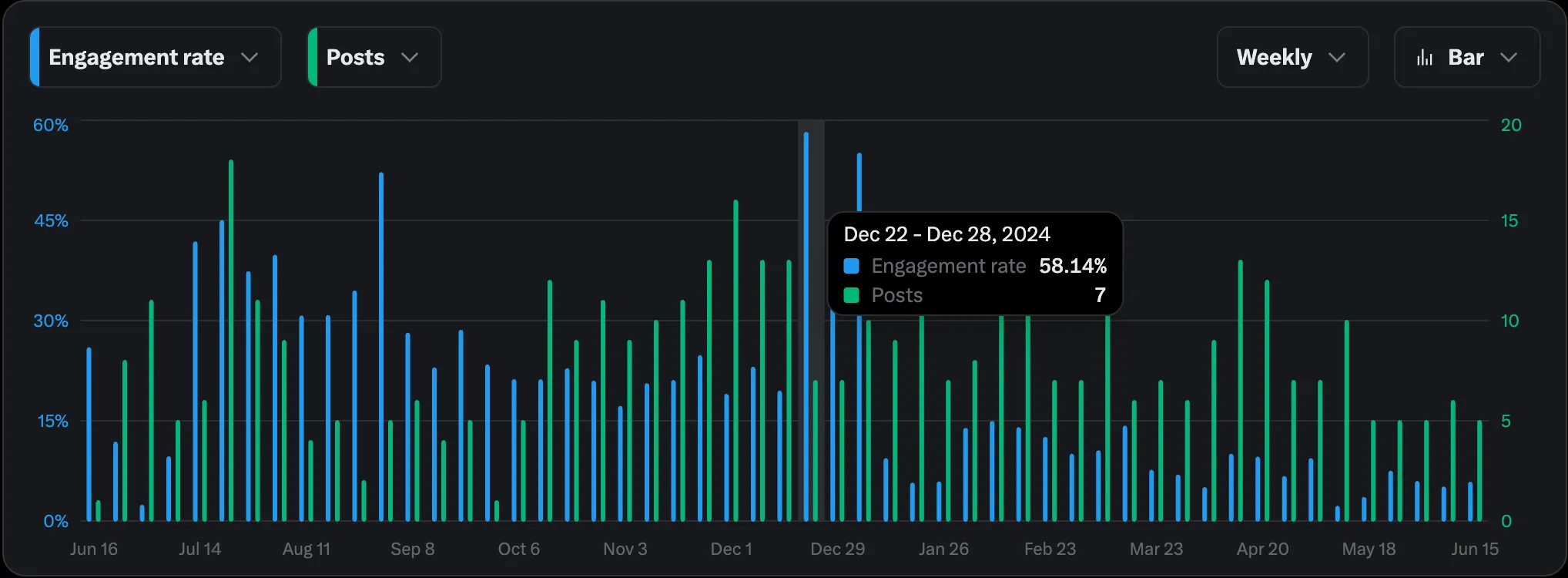
🧪 Is it Industry-Wide Applicable? Horizontal Comparison Table of Web3 Project Twitter Content Operations
We further selected currently active Web3 projects for horizontal analysis of their Twitter content operations:
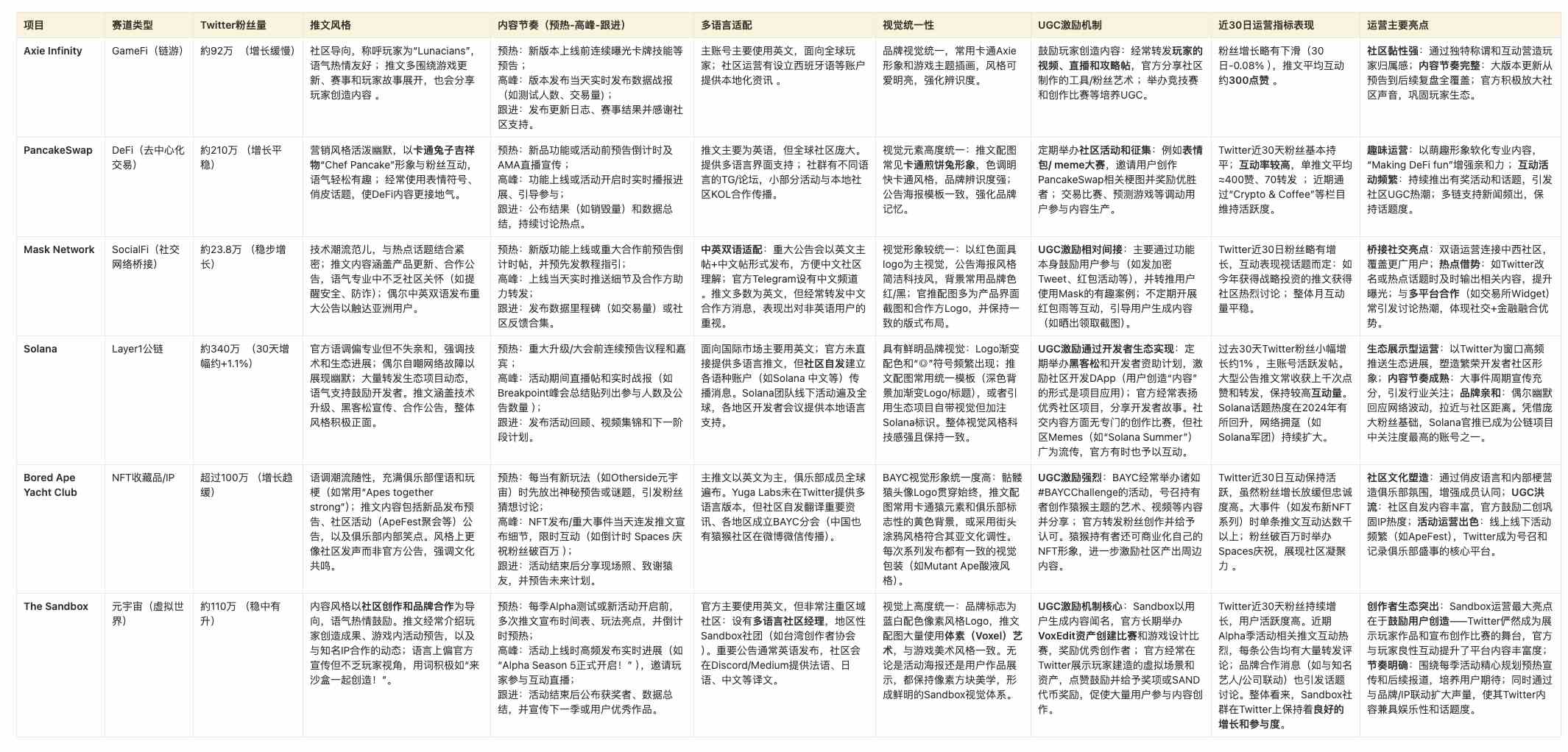
Table Explanation:
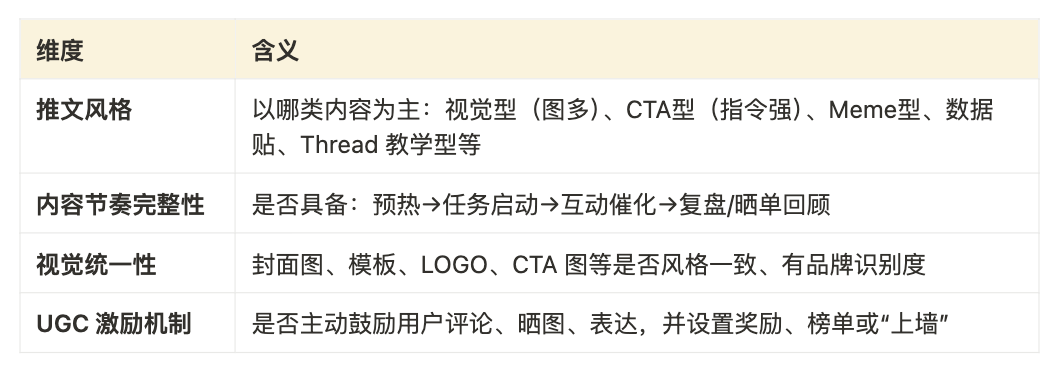
VI. Conclusion: It’s Not About Posting to Gain Followers, But Designing Behavioral Paths
We do not believe that "posting is completing a task." In the Web3 world, Twitter is the starting point of the user journey and a key battlefield for stimulating awareness, guiding actions, and solidifying loyalty.
A truly effective Twitter growth system is a comprehensive strategic project:
Core Concept Recap (Methodological Loop)

🧠 Summary of the Methodology in One Sentence:
Successful projects build content tactics through "rhythm + structure + guidance," achieving a path transition from attention to trust and from clicks to retention.
2|Web3 Campaign Design: Growth Relies on a Balance of "Incentives" and "Path Guidance"
Introduction
In our growth design for some marketing cases, we typically conduct multiple rounds of campaigns through task platforms (covering Galxe / QuestN / TaskOn). Past experiences tell us that truly effective campaigns are not just about "distributing rewards," but about designing a clear "behavior path": from curiosity → to trial → ultimately becoming community expressers. To this end, we break down and integrate from several dimensions: platform comparison, task structure, incentive strategies, and data monitoring.
I. Platform Comparison
Web3 task platforms serve as user growth tools, where the basic mechanism involves project parties publishing tasks, and users completing social follow-ups, on-chain operations, etc., to earn rewards. Although the positioning is similar, different platforms have their own focuses in terms of user demographics, task mechanisms, and growth outreach models. For ease of comparison, the following table summarizes:
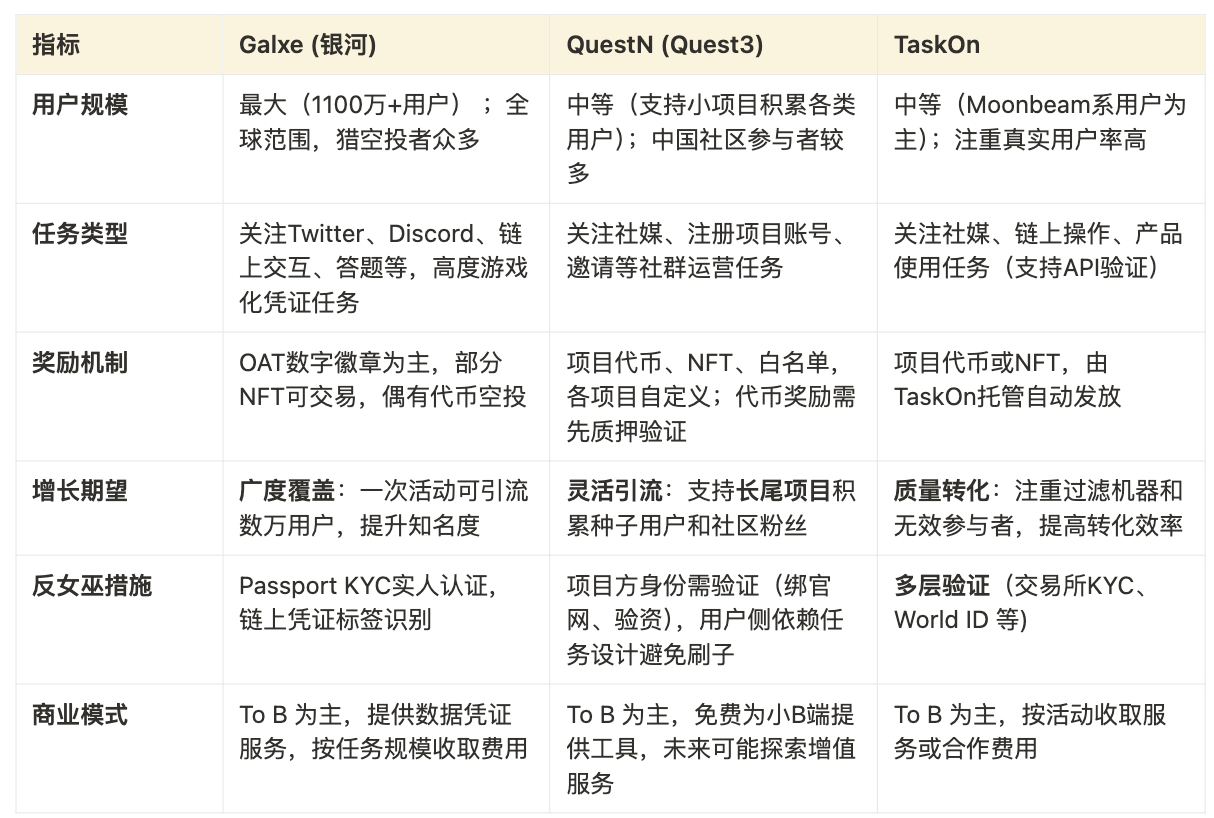
Despite the different platform types, the key is not the platform itself, but how to design the task structure. Choosing a platform is merely a "container"; structural design is the core engine of the campaign.
II. Rhythm Matrix & Key Node Feedback
In a campaign executed with a mix of QuestN + Galxe + TaskOn, we took a strategic GameFi project as an example, setting clear content rhythms and target action nodes, from world-building to on-chain behavior promotion, and then to community expression retention, forming a complete user path loop.
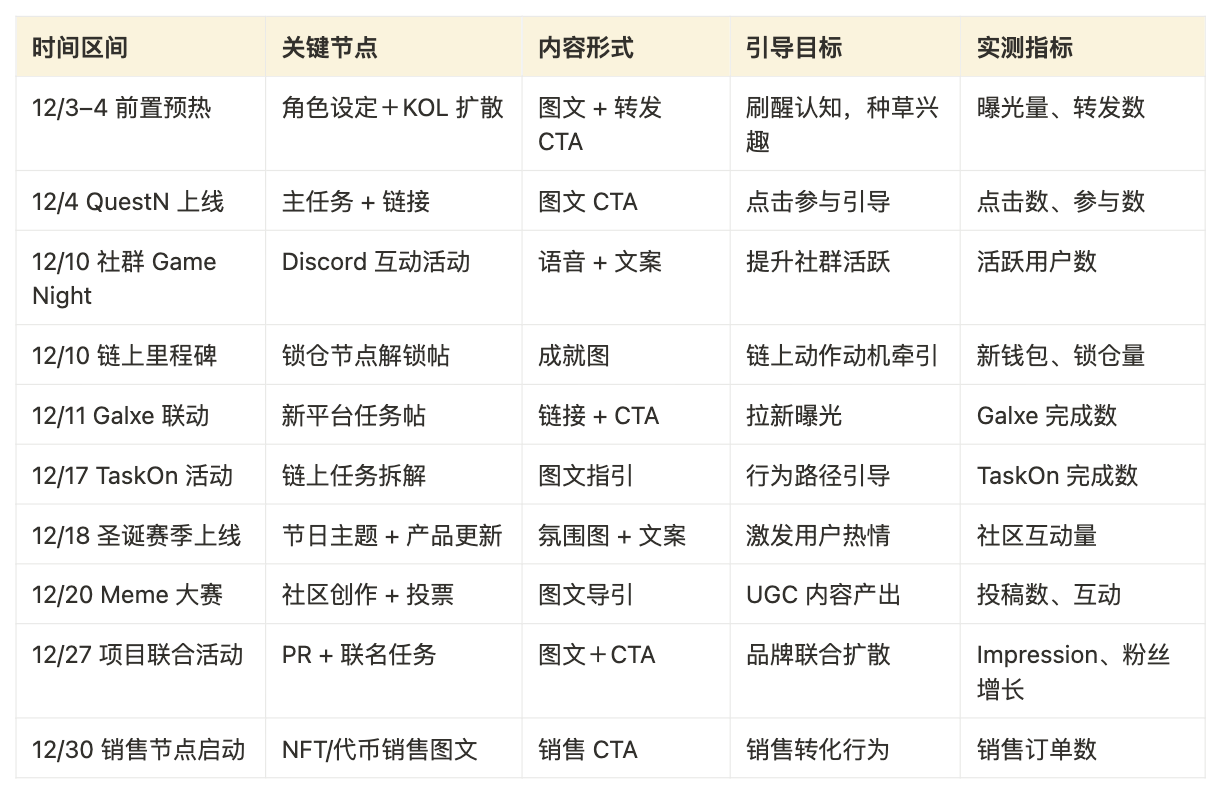
Stage Feedback Summary
Early Stage: Achieve "visibility" through preheating + world-building.
Mid Stage: Task rhythm + on-chain milestones encourage users to "be willing to try."
Late Stage: UGC and expression-driven mechanisms activate users to "be willing to retain."
III. Path Design: From Interest Guidance to Community Expression Behavior Path
A well-designed campaign often achieves several-fold growth in user numbers within a short time, bringing substantial on-chain interactions (transaction volume, TVL increase, etc.) to the project. The key lies in combining platform tools to build a behavior path from interest to expression.
This path consists of five stages:
1. Visual Induction: Cultivating Points of Interest
Establish the first impression through character setting images, emotional copy, and visual hooks to spark curiosity.
2. Layered Task Design: Gradual Thresholds
Light Operations: Follow, retweet, comment → Attract a broad user base.
Moderate Participation: Platform check-ins, minting, content screenshot uploads → Filter out low-quality users.
Heavy Tasks: On-chain locking, staking, UGC creation → Retain core users.
3. On-chain – Community Linkage: Enhancing Sense of Belonging
After users complete on-chain actions, they instantly receive Discord identity tags and automatically join task groups, solidifying community belonging.
4. Reward Rhythm Design: Rhythm Advancement and Exploration Drive
Early Stage: Low-threshold rewards quickly incentivize participation.
Mid Stage: Condition unlocking ↔ further challenge mechanisms.
Late Stage: Gain additional rewards and honors through expressive actions (e.g., sharing images, tweeting, leaderboard participation).
Set hidden tasks and Easter eggs to stimulate users' desire to explore.
5. UGC Driven + Leaderboard Incentives: Creating an Ecosystem
Encourage user expression through sharing images and leaderboards, forming a positive feedback mechanism of "you can also make the leaderboard," thus solidifying it as part of community culture.
IV. Task Design: Filtering Real Users, Paying Users, and On-chain Activists
Among a large number of campaign participants, there inevitably exist ineffective users (such as bots completing tasks, or low-quality accounts seeking easy rewards). Therefore, task design must strategically filter out real and valuable users, with a particular focus on the following three user groups: real users (eliminating bots/scammers), potential paying users (users with purchasing power who are willing to genuinely use the product), and on-chain active users (those who actually use the project's on-chain features). This can be approached from three aspects: guidance flow, verification methods, and filtering logic:
1. Guidance Structure: Employing Layered Task Paths.
Utilize a progressively challenging task structure that ensures the requirements become increasingly capable of distinguishing user quality. The entire task path design should resemble a funnel model: a large number of users enter from the starting point, gradually filtering out core target users.
First Layer: Low-threshold social media follows/retweets, covering a broad audience.
Second Layer: Questionnaire completion, screenshot uploads, raising participation thresholds and cleaning user quality.
Third Layer: On-chain interactions (minting, locking, staking, etc.), ensuring users genuinely use the product.
As task levels increase, only users with real interest will continue to participate.
2. Anti-bot Mechanism: Dual Verification of Identity + Behavior
Social Media Verification: Bind Twitter/X, record follow/retweet behaviors.
On-chain Verification: Filter real users through wallet interaction frequency and asset holdings.
KYC and OAuth: Verify identity through Galxe Passport, World ID, TaskOn OAuth, suitable for high-value reward stages.
Behavior Pattern Recognition: Combine on-chain address usage patterns to identify bulk addresses.
3. Layered Filtering: Assessing User Value
Participants who complete all basic tasks do not necessarily hold the same value, requiring further layered filtering to identify potential paying users and high-value users:
Active Contribution vs. Speculative Arbitrage: Analyze user behavior patterns in the campaign. Real users often actively interact on Discord, participate in AMAs, etc., while pure opportunists only perform minimal actions. Project teams can use the data dashboard of the task platform to view each user's task completion status, filtering out accounts that only complete a few tasks but attempt to claim rewards.
Purchasing Power Assessment: Potential paying users typically possess certain assets or are willing to pay for products. This can be evaluated using on-chain data: statistics on mainstream token balances in user wallets, whether they hold high-value NFTs, etc., as indicators of purchasing power.
Influence and Dissemination Value: For community-oriented products, it is also essential to filter users' social influence. Observe whether users generate secondary dissemination (e.g., retweets leading to additional clicks) and whether they actively speak in the community after completing tasks. Some platforms offer invitation rewards or leaderboards, which can measure the viral effects brought by users by counting the number of friends invited, tweet interaction volume, etc., identifying and retaining those high-impact users.
In summary, campaign design should utilize multiple task levels and verifications to filter users and combine data analysis for layered user assessment.
V. Balancing Incentive Mechanisms and Path Structures
In task marketing, the incentive mechanism (Reward) is a means to attract users, while path guidance (Guidance) is key to educating users about the product and achieving retention. An imbalance between the two can lead to issues: overly high incentives attract many profit-seekers with no intention to retain, while too low incentives make it difficult to draw users; insufficient guidance prevents users from learning product value, while excessive guidance may complicate processes and lead to user drop-off. The best practice is to achieve a balance between incentives and guidance:
Reasonably Set Reward Levels and Distribution: Adjust reward types and amounts based on the campaign's target audience.
New User Phase: Low-threshold rewards + sense of participation.
Action Phase: High-value rewards for overcoming threshold conditions.
Expression Phase: Guide users to share images, participate in discussions, and engage in leaderboard mechanisms.
Diversify Reward Forms, Emphasizing Honor Incentives
Leaderboards, OG roles, badge identities, Discord privileges, establishing a sense of belonging and identity.
User-Friendly Processes with High Educational Value: Ensure that task designs are friendly to newcomers while conveying product value. Avoid overly complicated operations; a straightforward guide for newcomers is crucial.
Data-Driven Real-Time Adjustments
Monitor task dropout rates and completion rates, dynamically optimizing reward or guidance designs.
Introduce variable reward mechanisms that automatically adjust reward structures as participation numbers increase.
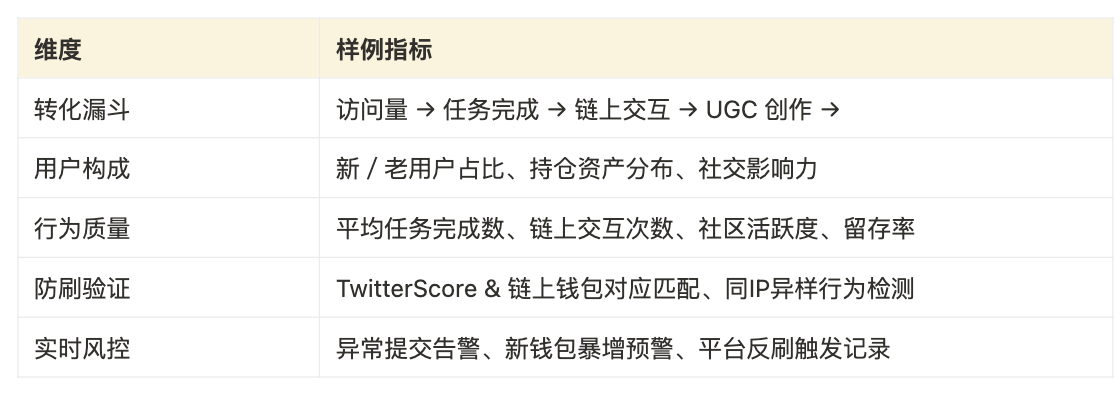
In summary, successful campaign design should ensure that users gain both rewards and knowledge/experience during participation. Incentives are a double-edged sword; excessive use can distort user motivations, while balancing with guidance as a shield can lead to healthy growth. As platforms like RabbitHole advocate, users should be guided to focus on contribution and value rather than merely seeking profit. Only when users remain due to recognizing the project's value can incentive investments be transformed into real community assets.
VI. Data Metrics and Tracking Mechanism Recommendations: Monitoring, Verification, and Optimization Loop
To assess campaign effectiveness and optimize user filtering, a comprehensive data metrics system and tracking mechanism is essential. Web3 growth operations are becoming increasingly data-driven. Here are the recommended metrics to focus on:
VII. Successful Cases: Web3 Campaign User Growth Practices
Excellent campaign cases can intuitively demonstrate the power of task marketing. Below are several representative Web3 project activities, analyzing their data results and key operations:
Movement Labs Parthenon (Galxe): Movement Labs, in collaboration with Galxe, launched the "Building the Parthenon" testnet journey, connecting over 50 DApps on a unified portal and setting up more than 400 tasks, attracting over 2 million users to participate. This event not only provided a real network stress test but also allowed the Movement community to grow rapidly, with Galxe Space followers reaching 2.7 million, X (Twitter) followers at 860,000, and Discord members at 840,000. Key Operations: Utilized the Galxe API to integrate multiple project tasks into a single process, designing challenges in the form of "six major guilds (Guild) + individual tasks," guiding users to complete exploration tasks and earn badge rewards, thereby significantly enhancing community engagement while uncovering testnet issues.
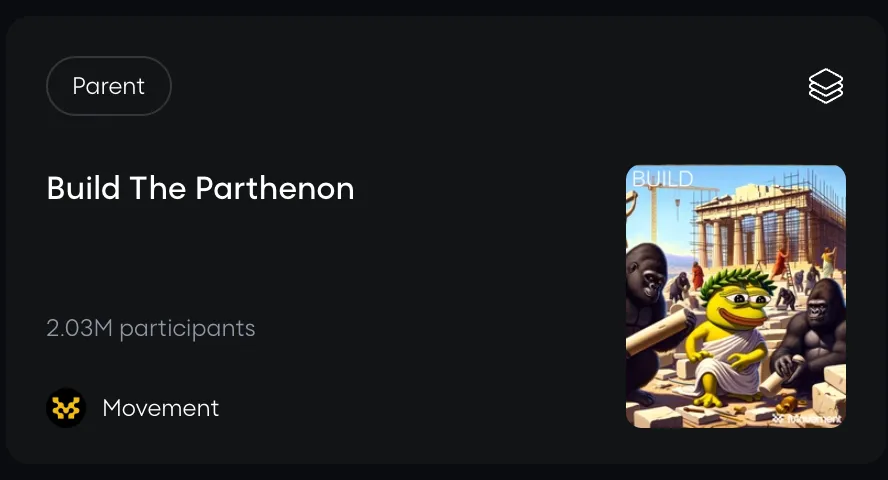
Hashflow Decentralized Trading Platform Growth (Galxe): A case disclosed in the Galxe platform white paper shows that the Hashflow project successfully increased its weekly active users from 3,000 to 13,000 by collaborating with Galxe to host the Hashbot Genesis NFT series of events. The specific approach involved issuing a series of "Hashbot Genesis" NFT badges, which users could claim in batches by completing designated trading tasks. The event included ten rounds of airdrops, resulting in a total of 20,000 NFT badges minted, directly driving Hashflow platform trading volume to exceed $250 million. By combining trading actions with digital badge rewards, Hashflow effectively incentivized users to interact repeatedly on the platform. Its CEO stated that the NFT infrastructure provided by Galxe met the event's needs well, becoming a powerful tool for project growth. Key Operations: Leveraged Galxe's credential NFT system to gamify trading tasks, airdropping rewards in phases to continuously stimulate user retention and trading activity.
Solana Multi-Protocol Joint Activity (Galxe): To expand the Solana ecosystem user base, the Solana Foundation, in collaboration with Galxe, launched the "2022 is Gonna be SOL COOL" campaign. This campaign spanned 27 protocols on Solana (including popular projects like Port Finance, Orca, Jupiter, etc.), with Galxe providing support to set tasks across multiple DApps. The event's prize pool reached $1 million, and users needed to explore designated protocols one by one and collect 27 NFT badges to participate in the reward distribution. This large-scale event generated widespread attention in the community, ultimately bringing over 30,000 new users to the Solana ecosystem. Key Operations: Created momentum through high rewards and multi-project collaboration, linking different DApp tasks via Galxe, allowing users to engage with the diverse applications of the Solana ecosystem in one go, achieving a bulk user acquisition effect.
Arbitrum Odyssey Event (Galxe): The Ethereum Layer 2 project Arbitrum launched the famous Odyssey series of events in 2022, setting a new benchmark for Web3 task marketing. The Odyssey was originally planned for 8 weeks, collaborating with Galxe to release exploration tasks covering bridging, DEX, NFT markets, games, and more, involving 56 ecological projects. Users could earn Galxe badge NFTs as rewards by completing specific project interactions each week, and continued participation in different weeks allowed them to synthesize special badges. Although the event was temporarily paused due to on-chain congestion, it still attracted hundreds of thousands of users to participate in interactions, being regarded as a significant success for community growth. Odyssey allowed users to deeply experience the Arbitrum ecosystem through task challenges, laying the foundation for subsequent user surges and ecological prosperity. Reports indicate that after its restart, Odyssey will continue for 7 weeks, involving new tasks from 13 selected projects, where users can earn personalized badges and potentially qualify for future airdrop opportunities. Key Operations: Large-scale, multi-phase task challenge activities, combining on-chain NFT badges and potential airdrop incentives to stimulate community-driven participation. Supported by the Galxe platform, it achieved unified hosting of dozens of DApp tasks, significantly enhancing user retention and recognition of the ecosystem.
QuestN Joint Marketing Activities: In addition to Galxe, large campaigns are also staged on the QuestN platform. For example, the Quest3 platform invited 50 project parties to jointly release task activities in July 2022, including well-known projects like CyberConnect, Mask Network, SafePal, attracting a large number of users to participate in different project tasks at once. This type of joint marketing allows multiple projects to share traffic, and users can earn various project rewards by completing a series of tasks, achieving a "one-stop airdrop experience." Key Operations: The platform organized multi-project joint airdrops, providing a continuous task chain to enhance participation, with each project offering rewards to increase the overall attractiveness of the event, fully utilizing the long-tail user base covered by QuestN for user acquisition.
VIII. Successful Mechanism Extraction + Operational Recommendations
Choose the right platform and model: Select the appropriate task platform based on project needs.
Adopt joint campaigns (multi-project collaboration) to expand influence.
Collaboration Project Selection Logic: Audience Overlap
When screening partner projects, prioritize: overlap of target users to ensure precise traffic.
The effectiveness of activities stems from the "synchronous initiation of multiple forces"; only when project parties are genuinely willing to participate and voice together can joint activities potentially have a viral effect. It is not enough for the platform to just post and link; users will not come automatically. We found that in every round of tasks, those with significant effects shared the following commonalities:
Project parties simultaneously promote tasks on their official website / Discord / Twitter.
Official accounts participate in retweets, explanations, and even engage in interactions.
Tasks have structured guidance in the community (e.g., group FAQs, operation diagrams).
Carefully Design Task Paths: Task settings should serve the goal conversion path for user growth. Follow a "broad net - fine screening" structure: first attract popularity with low-threshold tasks, then filter and screen with high-threshold tasks. The guidance process needs to provide clear instructions and support, reducing the difficulty for newcomers to complete advanced tasks (tutorials, customer service Q&A, etc.).
Moderate Incentives to Prevent Overexploitation: Reward schemes should be attractive but not subject to abuse. Control the balance between total rewards and individual user rewards, especially avoiding unlimited rewards (which can easily be exploited by scripts). Using a raffle + contribution weighting approach is relatively safe.
Focus on Retention and Continuous Operations: Growth is not the end; retention is key. After the campaign ends, there should be follow-up operations, such as bringing high-quality users accumulated during the event into the core community, continuously providing information access and special benefits, converting them into long-term users. Products and community mechanisms should be prepared for backend support: such as invitation experiences, transitioning to DAO (contribution and identity systems, etc.).
Conclusion
In summary, user growth for Web3 projects needs to shift from a rough "mass strategy" to meticulous operations. Task-based campaigns provide a powerful toolbox, but success depends on whether project parties can leverage data to understand users, carefully design processes, and continuously optimize. Platforms like QuestN, TaskOn, and Galxe each have their strengths; only by effectively utilizing their capabilities and combining them with their own strategies can they stand out in fierce competition and achieve truly effective user growth and conversion. Every real user participating in a campaign is a valuable asset to the Web3 community—through good screening and guidance, we can ensure that users gain value while the project itself gains loyal supporters, thus achieving long-term win-win growth goals.
3|GameFi Community Ecosystem Building: Efficient Strategies in Discord and Telegram
Introduction: Induction, Triggering, and Retention Community Operation Philosophy
In GameFi projects, the activity and cohesion of the community often determine the project's vitality. Instead of simply shouting for everyone to be active, a more effective strategy is to follow the philosophy of "Induction + Triggering + Retention": by inducing carefully designed incentive mechanisms to guide user participation and interaction, triggering various activities and topics to activate user enthusiasm, and retaining valuable content and core users to form the community's long-term assets and culture. This article will analyze how to utilize the functional mechanisms of Discord and Telegram to build an efficient GameFi community ecosystem, particularly elaborating on the strategies and roles of administrators (MODs) and core active users ("chatty" chatter) in user retention, topic guidance, and deep user participation conversion.
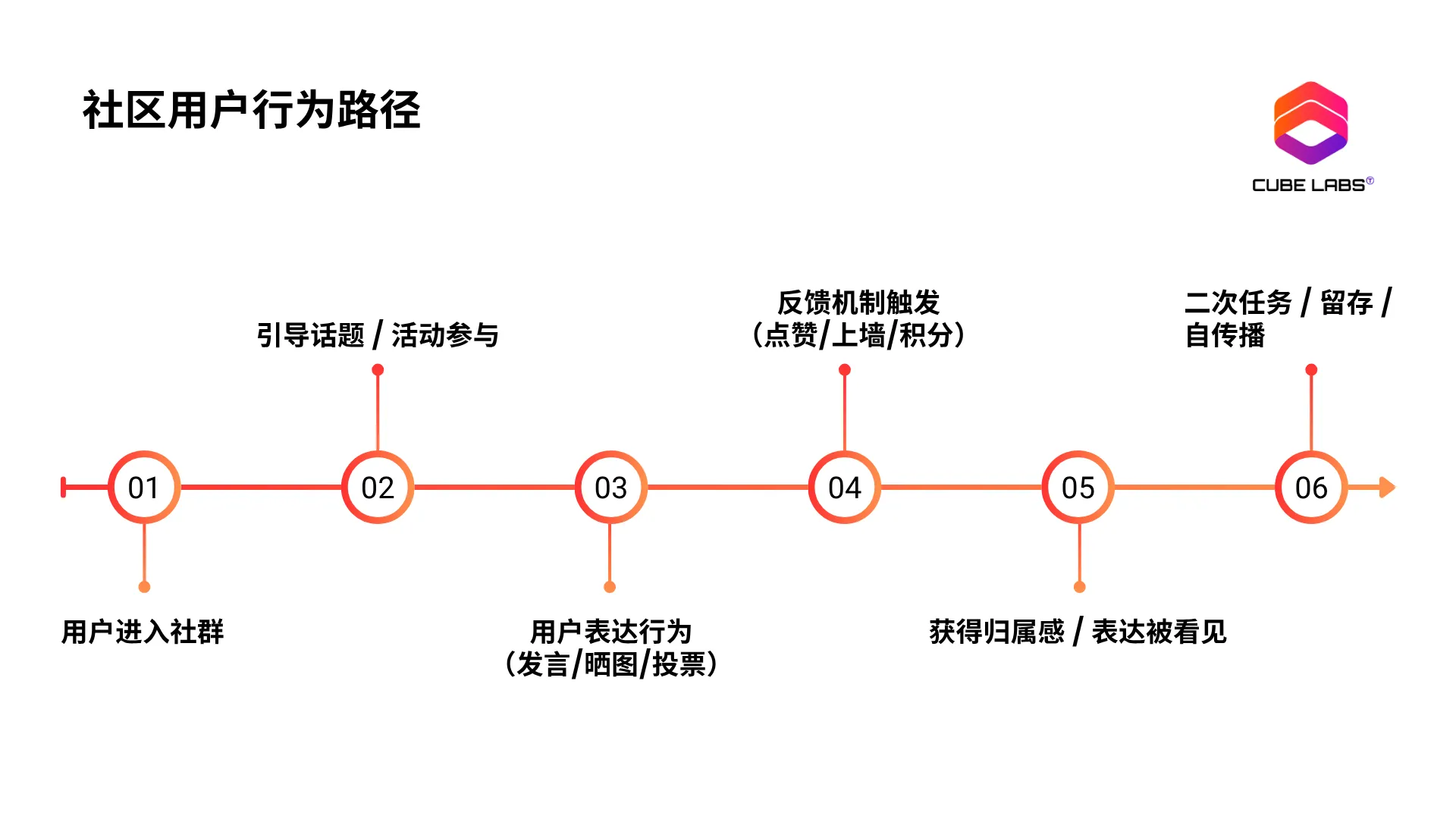
I. Community Structure Design: Channel Planning and Identity Layering
Discord and Telegram are the two core platforms for Web3 community operations, each with its advantages and clear divisions of labor: Discord is more suitable for structured community management, allowing for multiple channels, role permissions, and bot tools, making it ideal for building multi-layered, long-cycle interactions in NFT/GameFi communities; Telegram, on the other hand, emphasizes immediacy and rapid dissemination, often used for pushing announcements, real-time Q&A, airdrop interactions, and other high-frequency scenarios.
Most projects adopt a "dual-platform parallel" strategy: using Telegram to quickly guide new users and strengthen information reach; using Discord to facilitate in-depth discussions, user retention, and task-driven activities. A well-structured community framework is the foundation of an active ecosystem.
On Discord, it is recommended to set clear channel categories, including announcements, rules, general discussions, technical support, FAQs, and exclusive holder channels. Such divisions help keep discussions on different topics orderly and avoid information clutter. At the same time, implement roles and permissions to achieve identity layering among members (e.g., administrators, moderators, VIP members, newcomers), allowing for targeted community management. For example, exclusive roles and channels can be set for NFT/token holders, utilizing tools like Collab.Land to verify token-holding users, thereby granting special access permissions.
In Telegram, due to the lack of channel categorization features, the community structure is relatively simple. Generally, a main group is used for chat interactions, supplemented by an announcement channel limited to administrators for information dissemination. Pinned messages can be used to place community rules, FAQs, and other content, making it easier for new members to quickly understand community norms. Identity layering in Telegram mainly relies on group administrators and bot permissions (such as anti-spam bots), which, while not as detailed as in Discord, can still utilize verification questions or codes to screen new members and reduce the risk of bots joining in large numbers.
Regardless of the platform, a clear community structure and layering can enhance user experience, helping members meet their needs and establish a safe and orderly discussion environment.
II. User Retention and Maintenance of Daily Activity
1. New User Guidance and Retention: A Key Step in Building First Impressions
The starting point for user retention is a good "first encounter experience." In Discord, features like welcome pages and new user guides can be utilized, with MODs actively guiding new members to understand the community structure and participation methods, helping them "break the ice" quickly. For example, setting up action prompts like "Please introduce yourself first" on the welcome screen can help increase the speaking rate on the first day, thereby enhancing "first-week retention"—the rate at which new users remain active within 7 to 14 days of joining.
At the same time, using bots to automate welcome messages and guidance, timely sending links to announcements, task instructions, and identity claim methods can significantly improve new user activation rates. Appropriately arranging simple Q&A or quick tasks as "entry challenges" can also effectively enhance users' sense of participation and belonging.
2. Daily Activity Mechanism: Continuously Driving Interaction Frequency
To maintain daily community engagement, it cannot rely solely on "shouting for activity," but rather requires the design of ongoing content and incentive mechanisms. MODs can introduce gamification mechanisms, such as using bots like MEE6 to track speaking frequency and set up a points upgrade system, granting members different level identities and corresponding permissions. Users receive growth feedback from daily chats, forming a self-motivating feedback loop.
A leaderboard mechanism is also worth introducing: showcasing the top 10 most active users each week to create a healthy competitive atmosphere. Daily activities can include "check-in" and "topic Q&A" as lightweight tasks, with moderate rewards of badges or points. For Telegram communities, timed bots can be used to post questions and initiate polls daily, maintaining community activity frequency through light interactions.
3. Content and Activity Driven: Making the Community "Rich in Discussion" is Key
The activity of a healthy community comes from "predictable and interesting content output." The MOD team can develop a content calendar, planning daily topics and weekly activities, such as:
QOTD (Question of the Day): Light open-ended topics, like "What treasure did you find in the game today?"
Weekly AMA / Community Voice Activities: Hosted by project parties or experienced players, providing information and enhancing connection.
Mini-games / Polls / Check-in Challenges: Lowering participation thresholds and creating a sense of community rhythm.
A typical example is StepN, which regularly organizes community voice and running challenge activities, enhancing engagement and forming community traditions. MODs should continuously plan such activities and standardize execution rhythms, encouraging users to develop the habit of "checking in" daily.
4. Incentives and Feedback: Turning "Activity" into "Retention"
An effective incentive mechanism is key to transforming users from "bystanders" to "stayers."
GameFi projects often combine a dual strategy of "honor incentives + physical rewards." For example, Axie Infinity once distributed 2,000 tokens to the top 100 most active members in Discord, directly boosting community engagement. Role incentives are equally important, as titles like "VIP" or "Honorary Member" often come with unique permissions (such as testing priority, access to hidden channels), which are highly attractive.
In Telegram groups, bots can also conduct lottery activities or airdrop tasks, such as "check in for 7 consecutive days to enter a lottery," or randomly distribute token rewards among members who participate in questions during AMAs. Through regular small reward mechanisms, activity can gradually be transformed into retention, creating a sense of achievement and psychological belonging for users.
Sustainable community operations are not just about temporary excitement but about converting short-term activity into long-term retention, guiding immediate behaviors into deep identity recognition. When incentive mechanisms foster recognition, users will truly stay and form a stable community force.
III. Topic Guidance and Atmosphere Building: Creating a Culture of Continuous Interaction
An effective community is not measured by "the number of messages," but by whether it can continuously produce valuable topics and create a positive community atmosphere. High-frequency interaction does not equate to high-quality operation; the true art of operation lies in structuring design, rhythm planning, and cultural guidance to keep discussions centered around the community's core interests.
As someone once said: "The art of community operation is not about forced output, but about creating an atmosphere." A lot of member speech does not necessarily mean a good atmosphere; truly valuable discussions should revolve around common interests and be positively constructive.
1. Channel and Topic Design: Clear Structure to Guide Discussion
In Discord, structural design is the first step in topic management. A GameFi community typically includes multiple channels such as announcements, game discussions, technical support, player creations, and casual chat, each with clear descriptions and functional positioning. For example:
announcements: Used solely for official updates;
game-strategy: Encourages players to share strategies and character combination tips;
support: Specifically handles technical issues and account inquiries;
off-topic: An open casual chat channel to foster closer member relationships.
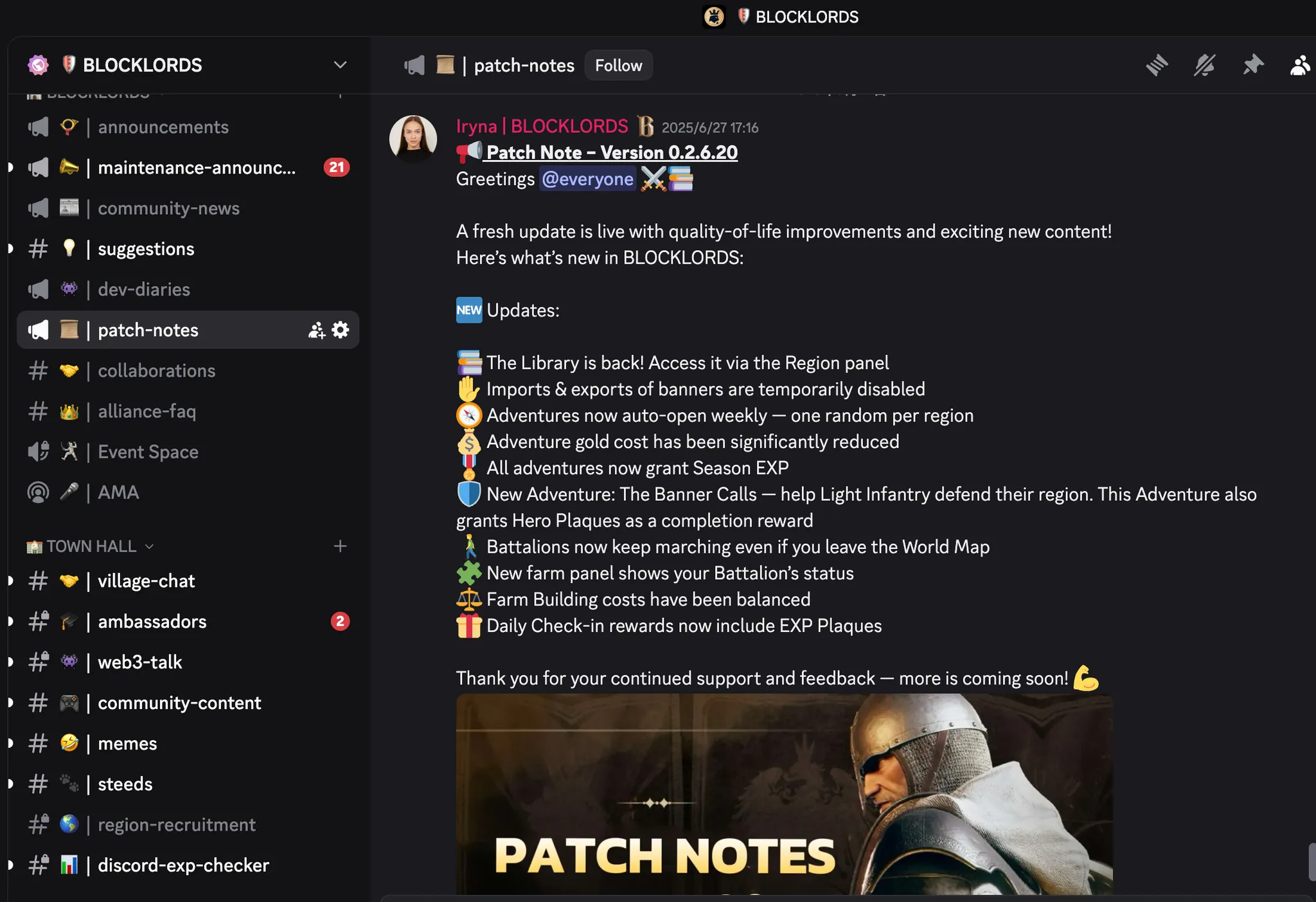
This "multi-person chat + multi-channel parallel" structure not only facilitates information management but also helps members find their own discussion scenes, thereby lowering the speaking threshold and enhancing willingness to participate.
In contrast, Telegram relies more on administrators actively initiating topics or using a "tags + time" system for ritualized management due to the lack of channel categorization. For example, every Monday could be designated as "Strategy Sharing Day," where administrators initiate "#Strategy Discussion" to guide members to share gaming experiences; every Friday could be set as "#Casual Friday," encouraging everyone to discuss light topics and enhance familiarity. Such fixed rhythm arrangements can help members establish participation expectations, serving as a practical way to operate topics on Telegram.
2. Guiding Content Rhythm: Discussions Can Be "Designed"
A healthy community should not always wait for users to "find topics," but rather MODs should actively play the role of "hosts," planning content rhythms and creating discussion opportunities.
The most basic way is to set up a topic list, selecting one to throw out each day (or week) to guide member participation. For example: initiating "What impact do you think this change will have on you?" around update content; or guiding users to share experiences: "Is there an underused lineup that actually works well?"… These lightweight, relatable, and easy-to-participate topics are most suitable for maintaining daily activity.
In addition, regularly holding themed discussion events is also an effective mechanism. For example, hosting a discussion led by MODs every Friday evening, choosing a direction (such as economic system adjustments, character balance suggestions, PVP experience sharing, etc.) to guide concentrated exchanges among members. Coupled with voice channels, live broadcasts, or AMAs, it can enhance the sense of ritual and participation.
To further enhance participation motivation, a certain "showcase mechanism" can also be introduced: for instance, establishing a "Star of the Week" selection, where administrators compile high-quality speeches weekly, selecting "Best Strategy Author" or "Most Helpful Responder," and publicly recognizing them in the channel. This mechanism serves as both an honor incentive and a way to filter content and accumulate community culture.
3. Community Culture and Rules: Turning Atmosphere into Habit
A good community atmosphere relies not only on administrator control but also on long-term cultural sedimentation. The task of MODs is to set clear rules and continuously maintain this atmosphere through tools and "soft guidance."
Institutionally, it is necessary to clearly prohibit negative behaviors such as spamming, insults, and personal attacks, using tools like Discord AutoMod or Telegram Rose Bot to set banned words and warning mechanisms, ensuring a basic safe discussion environment.
On a cultural level, encouraging "daily interaction rituals" among members, such as greeting each other with "gm/good morning" every morning, or using specific emoji expressions at important milestones, can create a sense of tacit understanding. Additionally, encouraging members to share failures and discuss interesting real-life stories can help diminish negative atmospheres like boasting and hierarchy, allowing newcomers to have a voice in the community.
Many successful GameFi communities have their own "community memes": some are classic voting moments, others are specific expressions used collectively during price fluctuations, and some even involve quotes from certain users being repeatedly referenced… This kind of "meme culture" not only brings a sense of belonging but also helps the community sediment a unique personality in an intangible way.
4. Identity System and Honor System: From Interest Layering to Contribution Incentives
Discord's emoji identity mechanism (Reaction Role) is a lightweight yet highly effective identity layering tool. Administrators can set up an "identity selection" channel, allowing users to customize their role tags by clicking emoji buttons, such as:
🎮 Player
🎨 Content Creator
🌍 Users of Different Languages
This not only enhances the fun of community interaction but also allows users to group by interest and find similar content by tags. Furthermore, "honor identities" and "special titles" can be established to recognize members who have made long-term contributions to the community. For example:
“OG Member”: Early participants who witnessed growth;
“Community Mentor”: Focused on helping newcomers;
“Gold Medal Chatter”: Contributors of quality topics and viewpoints;
These identities often come with visible rewards (such as special nickname colors, exclusive channel access, event priority, etc.), and may even be linked to future airdrops or NFT rights. This design that combines visual identity with actual benefits can effectively motivate user participation while creating a positive atmosphere of "effort being recognized."
IV. Promoting Users from Interaction to Deep Participation
The ultimate goal of community operation is to enable users to gradually grow from "bystanders" to "co-builders." In GameFi projects, this deep participation not only means sustained activity but also signifies that users begin to create value for the community—whether through content creation, task execution, or governance participation. To achieve this transformation, project parties need to systematically design participation ladders through content incentives, task mechanisms, on-chain rights, and co-building paths, gradually pushing users toward higher levels of participation.
1. UGC Incentive Mechanism: From User Content to Community Assets
Encouraging users to produce UGC (User Generated Content) can enrich the community's knowledge system and enhance users' emotional investment in the project. Common incentive methods include:
Initiate content collection activities, such as inviting users to write guides, record game videos, or create fan works;
Set up "content contributor" identities or badges to showcase and recognize outstanding works;
Regularly hold "monthly strategy awards" or "best author voting," with community members participating in the voting.
For example, the Frontier project once adopted community suggestions and encouraged players to co-build a Wiki. This mechanism allows content producers to gain visible achievements and stimulates more members to participate in creation. When users' content is cited or promoted by the official team, they spontaneously upgrade from "players" to "community creators."
2. Automated Tasks and Stage Challenges: Providing Users with Pathways and Rewards for Participation
Turning interactive behaviors into "tasks" is an effective means to push users into deeper participation. By utilizing task bots on Discord (such as Zealy, Quest3), project teams can set up:
Light interactive tasks like inviting users, sharing on social media, and forwarding screenshots;
Mid to high-level challenges such as completing testnet operations and participating in activity creation.
These tasks should have a progressive rhythm—attracting participation with low-threshold tasks and gradually guiding users to complete more challenging goals. In Telegram, tools like TaskOn and Quiz Bot can also be used to implement Q&A tasks and airdrop interactions.
Additionally, periodic challenges such as "community competitions" and "seasonal rankings" can significantly enhance participation willingness. For example, some projects set up PVP challenge tournaments or content co-creation months, where outstanding players can receive rewards like NFTs, airdrops, or special identities. Such mechanisms not only deepen users' understanding of the project gameplay but also enhance daily active users and user stickiness.
3. On-Chain Binding and Identity Rights: Turning Participation into Assets
To build long-term motivation for Web3 communities, it is essential to bind user behaviors with on-chain assets. Specific operations include:
Guiding users to bind their wallets, using tools like Collab.Land to verify NFT/token holdings, and automatically granting exclusive Discord/Telegram identities, such as "Holder" or "OG";
Setting up on-chain tasks + off-chain identity rewards, for example, participating in staking or liquidity mining challenges, which not only yield on-chain benefits but also unlock identities, badges, or leaderboard rankings;
Directly allocating a portion of Token Allocation to community contributors, such as Hop Protocol airdropping early active members on Discord, and ENS distributing 25% to community editors.
These mechanisms collectively send a strong signal: Participation = Earnings. When users realize that their actions have economic value, deep participation becomes a proactive choice.
4. Community Co-Building and Governance Mechanisms: Making Members "Collaborators"
After users complete "task-based participation," the next step is "strategic participation"—the co-building and governance aspect of the project. GameFi projects can gradually introduce DAO or community advisory mechanisms, such as:
Establishing a core player committee to regularly communicate project direction and gameplay feedback with the team;
Opening a community governance proposal system, allowing token holders to vote on important matters;
Setting up proposal discussion areas in Discord to collect ideas and improvement suggestions.
At the same time, active users can be "promoted" to roles such as community moderators, ambassadors, or official liaisons. For example, a certain GameFi project selected content contributors from the community to serve as "community ambassadors," granting them planning and community organization rights. This "co-building identity" not only enhances users' sense of belonging but also allows the project to achieve partial autonomy, improving overall operational efficiency.
V. Community Operation Strategy Matrix: Role Division Between MODs and Core Users
The promotion of deep participation does not rely solely on the project team; the exemplary role of core users is crucial. This is also the most critical collaborative mechanism between MODs (administrators) and community backbones. The following matrix summarizes the main strategies and roles of community administrators (MODs) and core active users under different community operation elements:
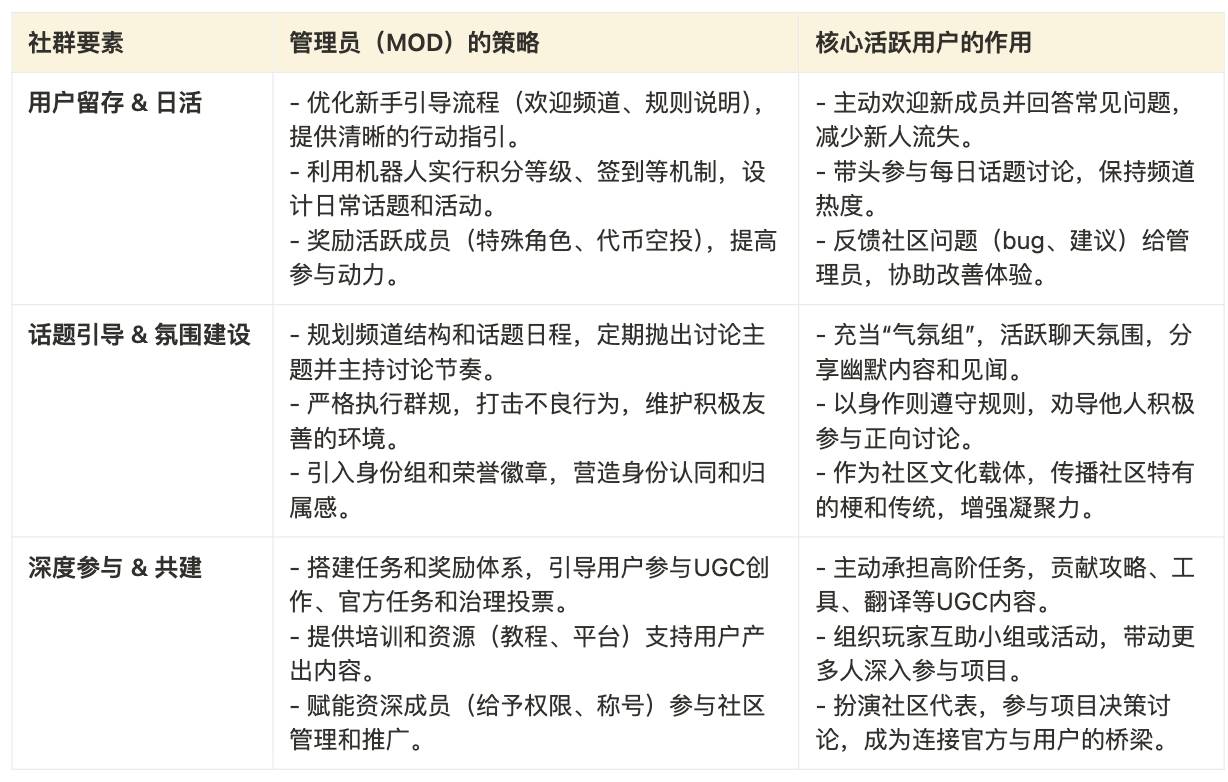
VI. Case Analysis: Community Operation Practices of Pixels, Blocklords, and Matr1x
Pixels has a Discord community with over 200,000 members. The official Pixels team has built a rich channel structure and guild system, facilitating players to exchange experiences under different themes. For example, they have a dedicated Guild channel for players to form or join in-game guilds and communicate and collaborate on Discord. Additionally, Pixels employs a wallet binding mechanism for Discord accounts to verify game asset holdings, thereby granting special roles and permissions to holders. In terms of incentives, the Pixels community regularly hosts themed events and challenges: a veteran player commented that they have been following the project since the "Carrot Incident" (an early creative event by Pixels), and Pixels frequently launches various integrated activities and themed competitions. These activities not only enhance the fun of the game but also encourage players to actively share their achievements and insights, creating a positive word-of-mouth effect.
Blocklords closely integrates gameplay with community incentives through Discord. During the community testing (Community Beta) in 2023, the official team announced rewards for the best-performing players, one of which was granting a special Discord identity—the "Founders Society" title. The first 100 players to receive this role not only gained access to an exclusive Discord channel to communicate directly with the development team but also automatically received benefits such as priority for subsequent NFT purchases. This approach effectively extends the competitive mechanism within the game to the community level, motivating players to actively participate in testing. Meanwhile, the Blocklords community also organized game content creation competitions: encouraging players to write guides, create memes, or live stream gameplay, with submissions entering a lottery for a chance to win rare legendary hero NFTs. This series of initiatives yielded significant results: on one hand, the game testing data became richer, and core players became more loyal; on the other hand, a large amount of high-quality player-created content spread across social media, helping Blocklords gain recognition.
Matr1x (Matr1x FIRE), as a first-person shooter mobile game in the metaverse, highlights its community operation through eSports events and multi-platform integration. Matr1x Discord has over 180,000 members. The project team places great importance on maintaining engagement through online events hosted by the community. For example, in 2024, they collaborated with the Community Gaming platform to launch the "Matr1x FIRE Open Tournament," inviting players worldwide to form teams and compete. The participation process requires players to join the official Discord and claim the "Matr1x Fire Player" role in the event area to receive announcements and rules. Through the tournament, community members not only experienced the thrill of competition but also strengthened their connection with the official team (administrators provide real-time answers to event-related questions on Discord). Additionally, Matr1x fully utilizes the combination of Telegram and Discord: they operate a Telegram announcement channel for timely updates on game changes and important notifications, while Discord handles daily player interactions and technical support. This strategy combines the broadcasting advantages of Telegram with the community discussion strengths of Discord. For instance, when a new game patch is released, the Telegram announcement quickly notifies over a hundred thousand subscribers, while detailed patch feedback and discussions take place in dedicated channels on Discord. The high engagement of the Matr1x community demonstrates the value of multi-platform operations: different channels serve their respective roles, collectively contributing to user retention and conversion.
Summary
The community of GameFi projects is not merely a simple information transfer station but the core battlefield for project growth, user conversion, and brand continuity. A truly vibrant community must build a self-operating ecosystem from "guidance mechanisms," "behavior pathways," "incentive designs," to "cultural sedimentation." When users are willing to create content for the project, spread ideas, participate in governance, and even bring in new users, they are no longer just subjects of operation but become collaborators of the project and co-owners of the ecosystem.
We hope everyone can achieve the ultimate goal of operation: not just "activity," but "self-sustainability."
4|PR Cooperation: Don’t Underestimate “Tweeting,” the Key is in “Timing”
—— Web3 Project Twitter Cooperation Announcement Release Guide
Introduction
In the daily operations of Web3 projects, cooperative PR is often simplified to a "routine task": post a picture, @ the partner, and add a tag to complete the task. But we want to say: Cooperative announcements should not just be "informational," but should become the starting point for user behavior.
Many teams will ask:
Why make an official announcement for a joint tweet that has no real integration?
We can write it ourselves; it’s just a tweet, why look for a marketing agency?
But in real user growth practices, we find that:
The true value of a cooperative tweet lies not in "whether it was posted," but in whether you hit the window of user attention, whether it sparked community participation, and whether it turned cooperation into a trigger for user trust.
Especially when the partner has a certain brand influence, the greatest potential of such content is:
Leveraging to amplify market voice;
Utilizing trust relationships for endorsement;
Embedding conversion pathways to guide user action.
This is not just about "who we partnered with," but about "you should get involved."
Next, we will break down the strategies for cooperative tweets from multiple dimensions, including structural design, release timing, content composition, and endorsement logic, to help you truly make the most of every "official announcement."
1. The Purpose of Releasing Cooperative Announcement Tweets
Amplifying market signals, creating hotspots, and triggering FOMO: Web3 projects often attract market attention by posting "partnership" announcements on Twitter, even if the cooperation itself has no substantial content. Such tweets can amplify market signals, conveying the impression that the project is "actively expanding" to the community, generating discussion heat, and creating a "Fear of Missing Out (FOMO)" atmosphere. Even if the cooperation content is shallow, as long as the narrative is well-crafted, it can become a weapon for creating the impression of "we are actively developing" and "being accepted by the mainstream ecosystem," activating community enthusiasm and FOMO emotions.
Leveraging Hot Topics to Enhance Project Visibility: Cooperative announcement tweets are often used to capitalize on industry hot topics to boost project popularity. If a hot topic arises in a certain field (such as Layer 2 airdrops or trending sectors), even if the project itself is not closely related, it may announce a partnership with relevant ecosystems to ride the wave of topic traffic. By announcing support for a popular public chain mainnet or planning to integrate a trending protocol, the project aims to increase its mention rate in hot topics and partially direct the attention of users focused on these trends towards itself. This kind of leveraging allows the project to gain short-term traffic benefits during hot moments, deepening the market's impression of the project's activity.
In summary, the core purpose of cooperative announcement tweets is core positioning: a content starting point of “creating credibility + guiding motivation,” marketing momentum, amplifying positive market signals, and generating discussion waves. Even if the cooperation content itself is limited, it should trigger community FOMO emotions through topic packaging, bringing attention and potential user growth to the project.
II. Practical Template for Cooperative Announcement Tweets
To maximize the effectiveness of cooperative announcement tweets, attention should be paid to wording and formatting optimization. Here is a practical template and key points:
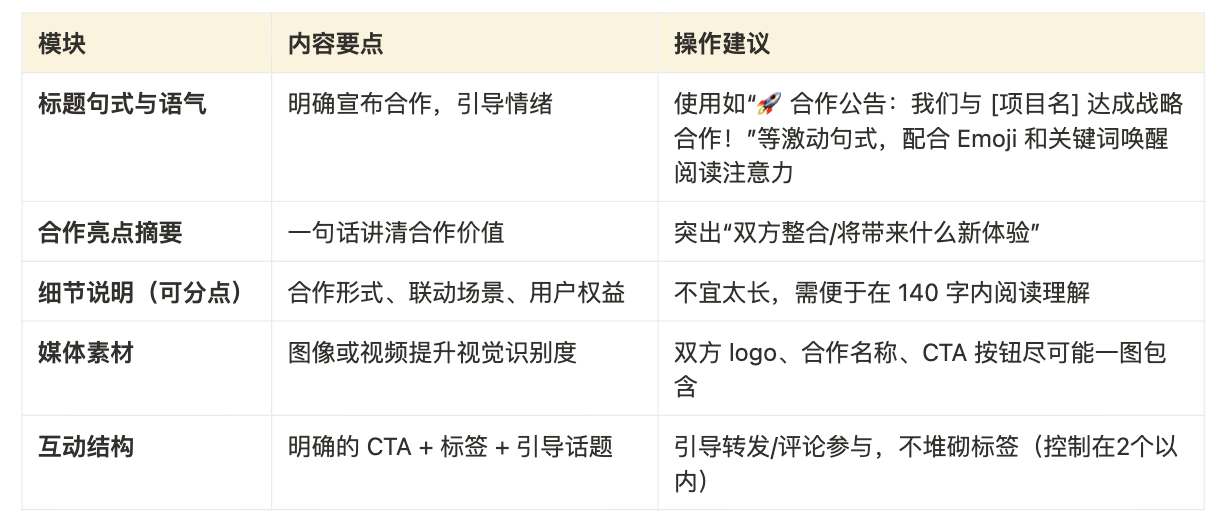
Supplementary Suggestions:
The images accompanying the cooperative tweet must have a “unified brand style,” with coordinated fonts/colors/visual composition to prevent a sense of dissonance, such as “you two don’t look like you’re collaborating.”
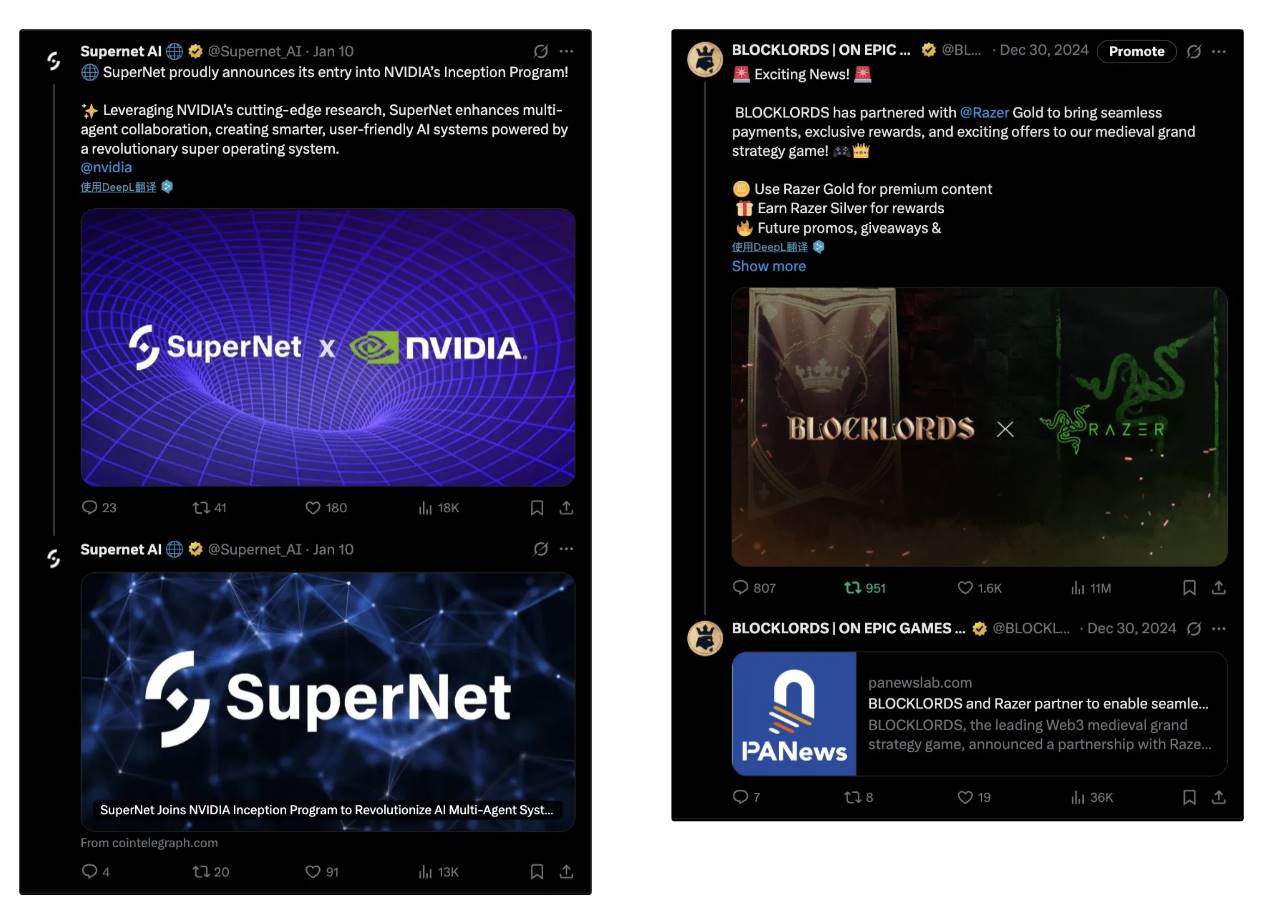
III. Timing Strategy for Release: Hitting the Right "Window" to Capture Traffic
Choosing the right time to release a cooperative announcement can significantly amplify its dissemination effect. The release timing strategy should be formulated based on the project's own rhythm, market sentiment, and audience activity times:
Project Rhythm Linked Release
Linking the cooperative announcement with important activities or milestones of the project can create a cumulative effect. For example, releasing related cooperative announcements around token launches, version updates, or major product launches can generate momentum for ongoing campaigns. Some projects even deliberately time their cooperation announcements to coincide with key milestones to create a “series of good news” effect, continuously stimulating market attention.
Market Sentiment Assessment
“Bull markets generate bullish news” is a golden rule in Web3 publicity. It is advisable to avoid periods of market stagnation or panic, prioritizing hot periods, favorable policy periods, and times around leaderboard announcements.
Audience Activity Timing for Release
For European and American projects, it is recommended to post in the afternoon UTC (morning Eastern Time + noon Continental Europe); for Asian projects, it is suggested to post between 8–11 PM; avoid holidays, major events, and other times that occupy attention. Overall, understanding the daily routines and habits of the target audience and posting during their peak activity times is key to ensuring the announcement is widely seen.
Simultaneous Release + Preheating Mechanism
The most effective cooperative tweets are usually “synchronized announcements from both parties,” with one party releasing a teaser about “a major cooperation coming soon” in advance to preheat community interest and create a countdown effect. This can achieve a diffusion effect of 1+1>2. This linkage strategy can merge the traffic of both communities, instantly igniting the topic and increasing the initial interaction volume of the tweet (retweets, likes). Twitter's algorithm tends to classify tweets with a certain number of native retweets as trending, further recommending them to more users. Therefore, through good timing choices and collaboration, cooperative announcement tweets can more quickly break through interaction thresholds and rise on trending topic lists.
Summary: When formulating a release timing strategy, it is essential to consider the project rhythm, market conditions, and target audience habits comprehensively. Coordinating simultaneous announcements from all parties at suitable time windows can maximize the depth and breadth of the cooperative announcement's dissemination.
IV. Excellent Case Analysis
Case 1: Bitget and MotoGP Cross-Industry Cooperation Announcement
In June 2025, the cryptocurrency exchange Bitget announced that it had become the official regional partner for some Grand Prix events of the MotoGP 2025 season. This cross-industry cooperation announcement achieved outstanding dissemination effects on Twitter. The tweet began with exciting statements: “We are thrilled to announce that Bitget is the regional partner for some MotoGP events in 2025! The first event will kick off at the legendary Mugello circuit…” This opening directly clarified the cooperation identity and created an atmosphere of excitement. The subsequent tweet and accompanying press release emphasized the theme of the collision of technology and speed, highlighting how this cooperation combines the extreme passion of racing with the efficiency and precision of cryptocurrency trading. Structurally, Bitget's promotional materials were rich in visuals: the tweet included images/videos combining the MotoGP venue with the Bitget brand, attracting users from both the sports and crypto circles through visual impact. In terms of topic selection, this cooperation spanned the fields of sports entertainment and blockchain, naturally generating discussion and attracting a large number of retweets. In terms of interaction data, the official announcement tweet from Bitget received coordinated retweets from KOLs in both the crypto and racing circles, enhancing exposure; simultaneously, industry media competed to report on the matter, sustaining the discussion heat. The success of this case lies in its clear structure (exciting announcement + key information + thematic elevation), novel topic (traditional sports × crypto finance), and achieving cross-boundary dissemination through multi-channel linkage, effectively enhancing Bitget's brand recognition both within and outside the industry.
Case 2: Carbon Browser's Multi-Round Cooperation Announcement Strategy
The emerging Web3 browser project Carbon Browser achieved significant results in its token issuance marketing through high-frequency, multi-partner cooperative announcements. In the period leading up to its token IDO, the team announced a new partnership on Twitter approximately every 3-4 days—partners included top public chains like Polygon, BNB Chain, and leading KOLs/investment institutions. This intensive official announcement created an impression of the project having strong connections and resource endorsements, continuously sparking community interest and discussion. Each tweet followed a similar template: enthusiastically announcing a “strategic partnership” with a well-known partner, briefly outlining the highlights of the cooperation, and @ mentioning relevant accounts to attract participation from the partner's community. After a series of favorable news bombarded the community in a short time, Carbon Browser successfully elevated market expectations. According to subsequent data statistics, this strategy helped the project achieve $1.6 million in IDO fundraising and a 4060% increase in token price after launch, while the number of community wallet addresses and DApp downloads also surged. This case demonstrates the power of a “big-name partnership” announcement matrix in marketing: even if individual partnerships may not be deeply rooted, frequent announcements with big names allow the project to quickly amplify its voice. In terms of the structure of these tweets, the Carbon team consistently maintained **conciseness and substance: highlighting the partner's name and the significance of the cooperation, allowing the audience to repeatedly receive the signal of “we are being recognized/supported by various parties,” thereby building market confidence and FOMO emotions. Notably, Carbon also complemented its cooperation announcements with marketing through other channels (such as PR news, community airdrop activities), creating a synergistic effect. Therefore, its successful experience lies in *high-frequency quality cooperative announcements + multi-channel synchronous promotion*, generating momentum for the token issuance and achieving excellent operational results.
V. Why Professional Agencies Are Needed to Plan These Announcements
Carefully planning a series of successful cooperative announcement tweets often requires the assistance of professional marketing agencies. Reasons include:
Content Arrangement and Creative Control: Professional agencies have experienced copywriting and design teams familiar with the expression styles preferred by the crypto audience. They can design the optimal wording and layout for tweets based on the characteristics of the partners, ensuring accurate information delivery and sufficient eye-catching appeal.
Network Expansion and KOL Coordination: Top crypto marketing agencies have extensive networks of KOLs and media resources. They can quickly mobilize leading industry accounts to coordinate retweets when the project announces a partnership, amplifying visibility. Compared to project teams contacting influencers individually, agencies are more familiar with which KOLs are suitable for the project field and which communities/channels the announcement should be placed in for the best effect. Additionally, agencies can arrange for executives from both parties to participate in interviews or appear together on Twitter Spaces, cross-directing traffic between communities, allowing the cooperation message to penetrate more circles.
Media Operations and Result Assurance: Professional agencies typically incorporate Twitter announcements into a comprehensive media plan, providing full-process operational support. Many crypto marketing companies will simultaneously pair news releases, forum posts, Telegram announcements, and other methods to ensure that cooperation messages are exposed across all mainstream channels. They will also set KPIs (such as retweet volume, click-through rates, new follower counts, etc.) and continuously optimize content delivery, taking responsibility for the final results. For project teams lacking experience, this professional operation not only saves time and effort but also significantly enhances the quality and success rate of announcements.
Risk Control and Credibility Endorsement: Experienced agencies are adept at avoiding pitfalls in announcements, ensuring that the content complies with regulations and that public relations risks are manageable. Moreover, large agencies have a certain level of credibility within the industry, making promotional efforts planned in collaboration with them more likely to gain media trust and attention. This inherently adds authority to the cooperative announcement, making the audience more willing to believe in the authenticity and importance of the message.
In summary, in the increasingly competitive Web3 market, leveraging professional marketing agencies to plan cooperative announcements has become a wise choice for enhancing dissemination effectiveness. Professional agencies can provide comprehensive support for the project from content creativity, networking resources, channel operations, and risk control. This not only amplifies the value of a cooperative announcement tweet but also ensures the orderly and efficient execution of the entire marketing campaign, ultimately helping the project achieve a leap in visibility and brand recognition.
Summary
The value of an “official announcement tweet” goes far beyond just “being sent out.”
In the attention market of Web3, every cooperative announcement is an opportunity window to ignite user trust and guide behavioral pathways. We should not view it as a ceremonial task but integrate it into a complete dissemination rhythm. From “release structure” to “release timing,” from “content format” to “interaction guidance,” every link can be designed, amplified, and transformed.
Especially when the partner carries influence, it becomes a golden scenario of “brand leveraging + user psychological guidance.” With the professional creativity, networking, and release rhythm design of an agency, project teams can turn a simple tag into:
Content hooks that users are willing to share;
Topics that media are willing to report on;
Endorsement effects that the market is willing to believe;
Behavioral entry points that the community is willing to participate in.
This is what constitutes a “meaningful cooperative tweet.”
In the Web3 era, where attention is diluted, it's not about whether you have posted, but whether you have tapped into the rhythm and psychological structure of users. Truly effective PR is never about “informing,” but about “initiating”—
Before your next tweet, consider trying one or two items from this rhythm chart; you might discover that a single collaboration can leverage an entire chain of attention.
5 | Traffic Acquisition Strategies for Web3 Projects on Mainstream Web2 Advertising Platforms
Introduction
In the growth logic of Web3, advertising has long ceased to be a crude method of “burning money to attract users,” but rather a game of content, conversion, and audience. Different platforms, project positioning, and audience groups hide vastly different cost structures and strategic choices behind them. In this article, we will systematically break down: advertising cost comparisons across platforms and advertising strategies and user path designs for GameFi, DeFi, and Layer 1 projects.
I. Advertising Cost Comparison Across Platforms (CPC/CPM/CPA)
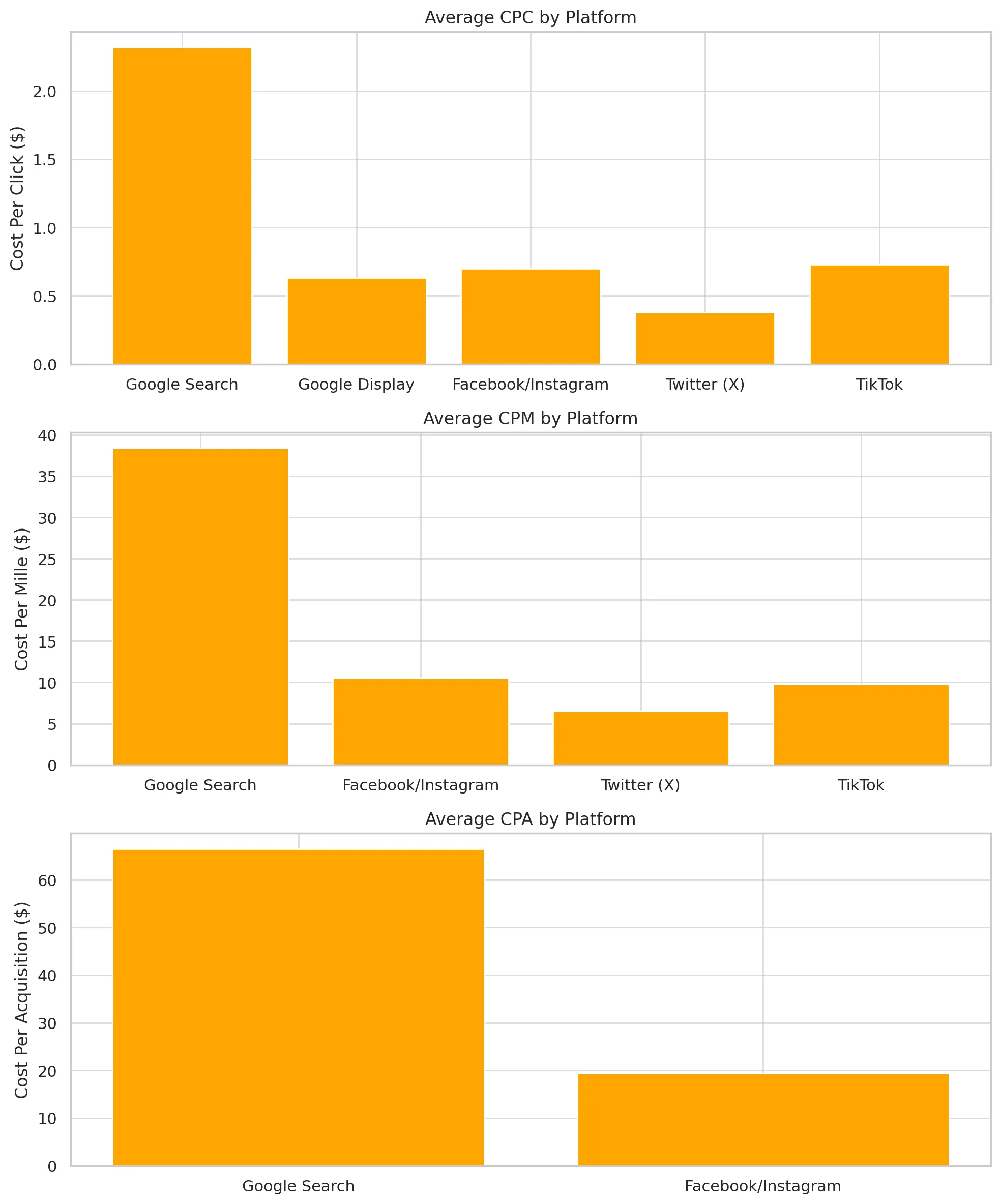
The advertising costs across different platforms vary significantly, and these differences determine the cold start strategies and budget allocation logic in the early stages of a project.
Taking cost-per-click (CPC) as an example:
Google Search Ads have a strong intent capture capability, leading to fierce competition, with an average CPC reaching $2.3, but the conversion rate for precise users also increases accordingly.
In contrast, Google Display Ads (GDN) have a CPC of only $0.67, making them more suitable for brand exposure or remarketing stages.
Facebook / Instagram typically have a CPC ranging from $0.6 to $0.7, but there are huge disparities across different industries; for example, financial products can reach as high as $1.3.
Twitter (X) has the lowest click cost across all platforms, at about $0.38, making it very suitable for early community exposure and low-cost traffic acquisition.
TikTok has a CPC ranging from $0.5 to $1, with a CPM (cost per thousand impressions) of about $10, offering good cost-effectiveness, especially for visually driven products.
Now looking at the cost per thousand impressions (CPM):
Google Search CPM is the highest, around $38, driven by high competition due to strong intent.
Facebook / Instagram have a CPM of about $8 to $13, which is at a medium level.
TikTok CPM starts at $10, but due to its algorithmic recommendation mechanism, the quality of the material greatly affects traffic differences.
Twitter CPM is the lowest, around $6.5, making it budget-friendly and suitable for amplifying dissemination with quality content.
Additionally, we cannot overlook the cost per acquisition (CPA):
The average CPA on Facebook is about $18.7;
For Google Ads, acquiring a potential customer lead can have an average CPA as high as $66, especially in highly competitive industries like finance and law.
This means that if you are working on GameFi, the advertising goal is likely to attract new downloads or guide registrations, making CPC important; whereas if you are working on Layer 1, focusing more on brand trust and developer ecosystem building, CPM + content exposure becomes more critical.
II. Advertising Strategies and Audience Positioning for GameFi, DeFi, and Layer 1 Projects
1. GameFi: A Triad of Fun, Profit, and Spreadability
GameFi projects are essentially a composite product of “entertainment content + asset-based incentives,” targeting both traditional gamers and crypto users. This dictates that its advertising strategy must simultaneously consider visual appeal, gaming fun, and profit expectations.
Material Strategy:
High-quality gameplay demonstration videos
Screenshots showcasing player earnings
Visual impact images of NFT items
Edited KOL gameplay/live challenge videos
Platform Pathways:
TikTok: Suitable for viral spread through challenge videos and quick gameplay demonstrations, especially for mobile GameFi.
Facebook / Instagram: Utilize interest-based targeting, such as “action games” or “card games,” combined with crypto interest packages for precise coverage.
Twitter: Used to target users who already follow GameFi KOLs or competing projects, enhancing project discussion.
YouTube / Twitch: Collaborating with game streamers is a key node for amplifying voice and building trust.
Strategy Keywords: Multi-point deployment + content virality + KOL collaboration + community task closure
Cautions: Facebook's review process is stricter for crypto projects, and TikTok's material creativity is crucial for survival; material quality directly impacts CPI costs.
2. DeFi: Investing in Products, but More in Trust
DeFi users generally possess strong professional capabilities; they do not require “instant gratification” but focus more on the robustness of product structure, clarity of profit models, and platform security.
Material Strategy:
Illustrative explanations of profit structures
Short educational videos on DeFi, case analysis illustrations
Screenshots of audit reports, security endorsement content
Platform Pathways:
Twitter: Users who follow major financial accounts and KOLs are the most precise target group. DeFi projects can quickly establish authority through paid tweets and participation in trending topics.
Google Ads: Search keywords like “highest yield farm” or “DeFi staking platform” remain effective, especially for global users.
Facebook / Instagram: Combine educational content for advertising, then use remarketing ads to recall users who visited the official website but did not convert.
On-chain advertising networks: Some platforms now support “wallet address targeted ads,” allowing for precise targeting based on on-chain behavior, locking in users of a specific protocol or whale groups.
Strategy Keywords: Content-first + education-centric + security endorsement + user remarketing
Cautions: The conversion path for DeFi is longer, generally requiring multi-step guidance through tutorial pages, wallet connection pages, etc. It is strongly recommended to link with Telegram/Discord community activities.
3. Layer 1: Advertising ≠ Conversion, but Technical Endorsement and Ecological Resonance
The advertising goal for Layer 1 public chain projects is not short-term ROI, but rather long-term ecological construction, developer recruitment, and brand engineering for technical credibility. Therefore, the advertising strategy leans more towards “brand PR + community building.”
Material Strategy:
Mainnet launch, funding announcements, technical white paper interpretations
Partner endorsement images, TPS performance displays, hackathon recruitment information
Developer tutorials/documentation access
Platform Pathways:
Twitter: The most important platform. Most developers and core users gather here. Important nodes will conduct trend topic advertising, with costs reaching $200,000/day.
LinkedIn: Used to showcase technical vision, recruit developers, and convey enterprise-level cooperation signals.
Facebook / Instagram: Deploy lightweight video ads for brand exposure, guiding users to follow communities or subscribe to news.
Industry Offline: Advertising in conference settings (like DevCon), sponsoring hackathons, and landmark outdoor advertising to reinforce online advertising.
Strategy Keywords: Technical credibility + brand endorsement + ecological call + multi-platform linkage
Cautions: Conversion goals are often “learn more” or “join the community,” and advertising effectiveness should not be measured by traditional conversion ROI. Advertising targets should be segmented by audience: speak to developers about technology, to investors about cooperation, and to users about incentives.
III. Differences in Advertising Performance Across Platforms and Adaptation Scenarios
🌐 Adaptation Comparison Table for Major Web2 Platforms in Web3 Project Advertising
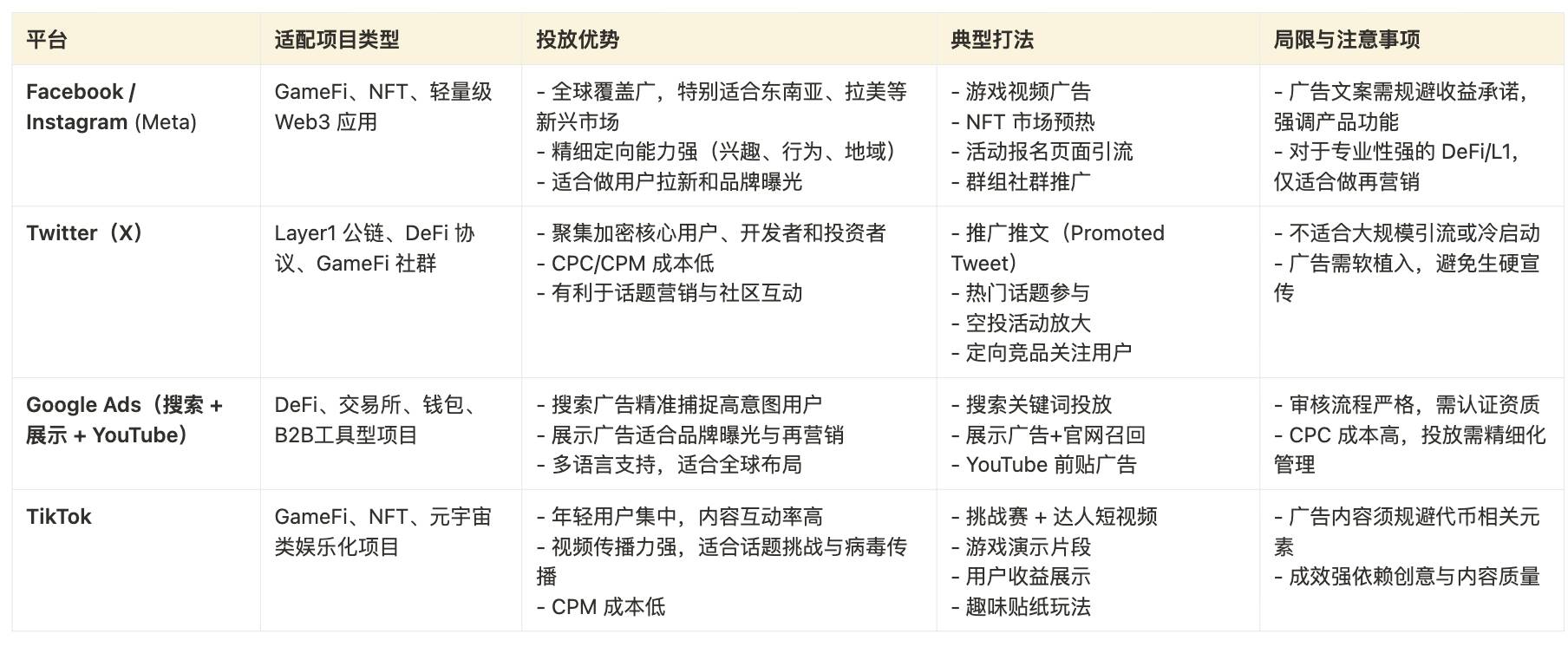 📊 Overview Table of Platform Adaptation Scenarios (Purpose-Oriented)
📊 Overview Table of Platform Adaptation Scenarios (Purpose-Oriented)

IV. Differences in Advertising Data and User Performance Across Regions
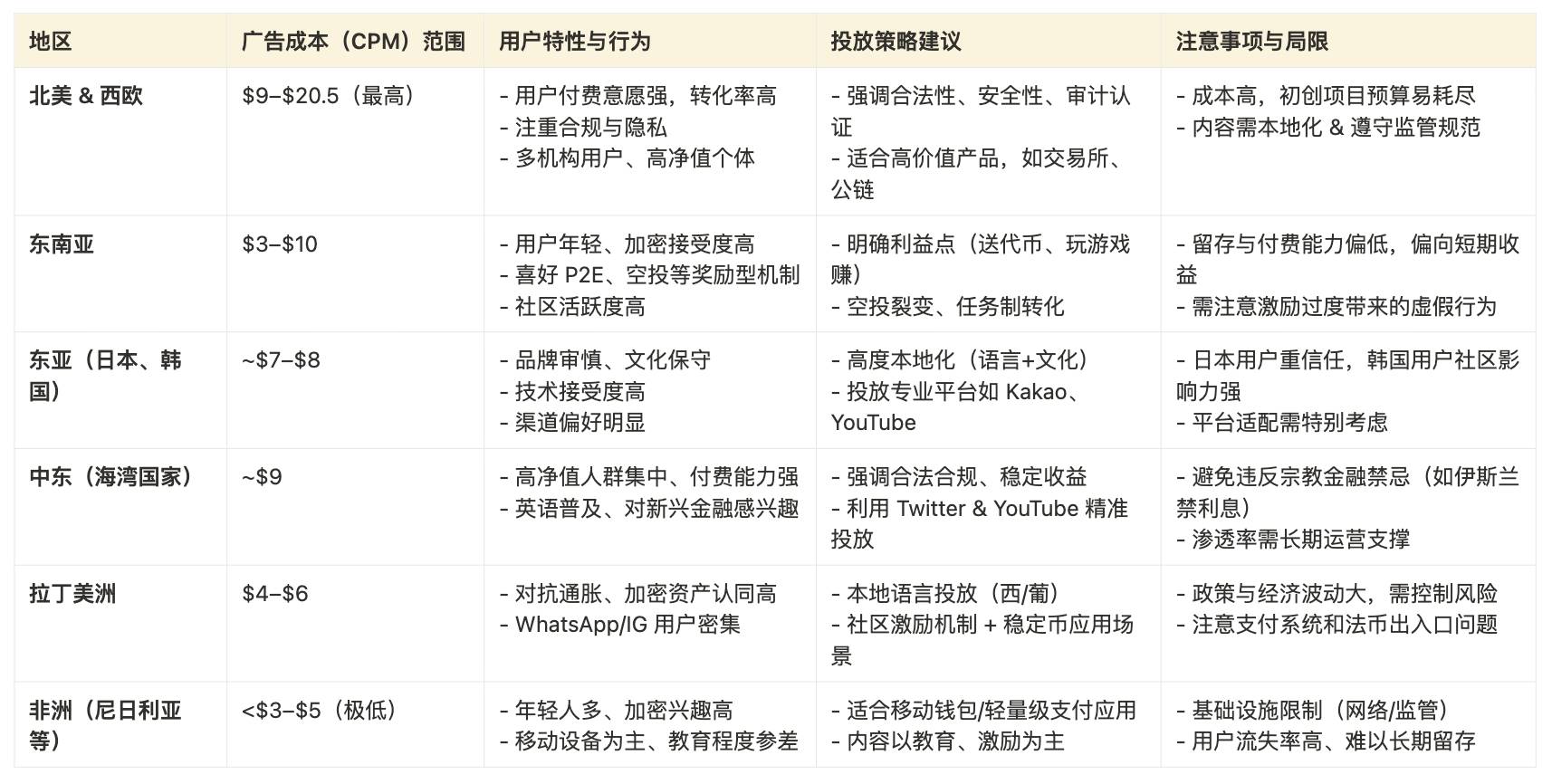
📊 Regional Advertising Strategy Summary Table (Adapted by Advertising Purpose)
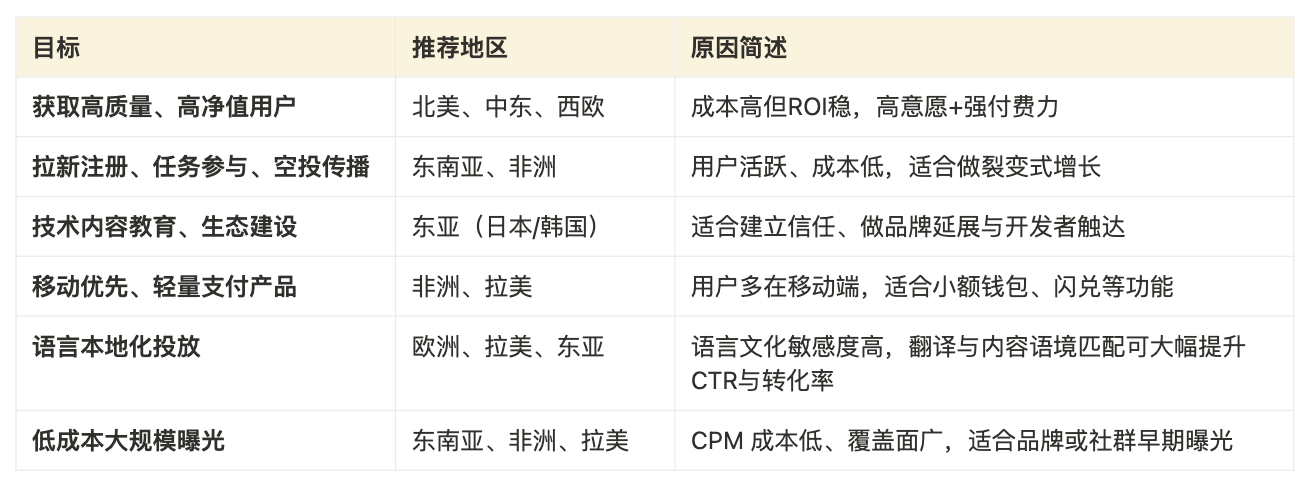
In summary, different regions exhibit a pattern of “cost-return” trade-offs in advertising: developed markets have high costs but high user value, while emerging markets have low costs and large user volumes but need to improve retention and monetization. A wise strategy is to adjust advertising by region: for example, gaming projects can tilt their budgets towards Southeast Asia and other gaming hotspots to build a user base while promoting their brand in North America and Europe; DeFi projects should focus on establishing credibility in Europe and the U.S. while attracting incremental users in Asia, Africa, and Latin America. It is essential to emphasize that regardless of the region, attention should be paid to localized operations, including language, culture, and compliance requirements, to enhance user trust and participation. By analyzing data performance across different regions and dynamically optimizing, Web3 projects can maximize the ROI of advertising in each regional market.
V. Five-Step Closed Loop for Successful Web3 Advertising: From Creative Testing to ROI Verification
In the Web3 world, advertising is not just about "buying traffic." Projects that achieve high ROI often have a structured, data-driven, and closely coordinated advertising system behind them. From early material testing to user path design, and then to ROI modeling and strategy iteration, excellent advertising goes beyond clicks; it is about final conversion and retention.
Below, we will break down the core strategies of successful projects in advertising through five typical stages.
1. Start with "Small Scale Testing": Advertising Planning and Testing as the Starting Point for ROI
Before any large-scale advertising campaign begins, top projects almost always conduct a round of small-scale but high-density testing. Through A/B comparisons of multiple versions of ad copy, various material forms (banners, short videos, animated GIFs, etc.), and different audience combinations, they attempt to answer two key questions:
Which type of creative can attract users the most (i.e., higher click-through rates)?
Which type of user has the best conversion performance (i.e., higher registration or transaction conversion rates)?
For example, a GameFi project tested both "cool battle videos" and "player earnings screenshots," discovering that battle videos had a 30% higher click-through rate, leading them to shift the main budget towards video content.
Although these early trial-and-error investments are small in scale, they directly influence subsequent budget allocation and content style, determining whether a large-scale launch is worthwhile.
2. Creative Style: Beyond Attractiveness, It’s More Important to Clearly Communicate Value
Compared to traditional advertising, the challenge of Web3 advertising creativity lies not only in being eye-catching but also in meeting platform compliance requirements.
In terms of visual presentation, different project types typically choose different expression methods:
GameFi emphasizes the impact of game visuals, the attractiveness of rewards, and the enjoyment of gameplay;
DeFi focuses on rational trust elements such as yield data, audit reports, and endorsements from investment institutions;
Layer 1 public chains lean towards a sense of technology and futuristic narratives, reinforcing technological advancement and ecological vision.
From a practical perspective, dynamic videos or animated images are far more attractive than static posters, especially on platforms dominated by short videos like TikTok and Instagram Reels, where quickly grabbing attention is the first step.
Additionally, ad creatives must include a clear CTA (call to action), such as "Play now," "Connect your wallet to win an airdrop," or "Participate in staking to earn rewards." These clear instructions are the driving force behind user actions and often determine whether users stay or leave after clicking.
But most importantly: the content must be authentic and credible, avoiding exaggeration or implications of exorbitant profits. Strict platform reviews are one aspect; more crucially, user trust is hard to rebuild. Many successful ads cite third-party information such as professional media reports, community review screenshots, and on-chain data as "trust anchors" to enhance persuasiveness.
3. Finding the Right People is More Important than Saying the Right Words: Audience Targeting and Execution
No matter how good the ad is, if it is not delivered to the right people, it is futile. Audience targeting is the core determinant of conversion efficiency.
Most projects will simultaneously employ the following methods:
Interest-based targeting: such as "cryptocurrency," "blockchain games," "NFT collectibles," etc.;
Lookalike audiences: finding users with similar behavioral patterns based on existing registered users;
Geographic + language targeting: delivering different versions of ads to users in different countries and regions;
On-chain data targeting: using third-party crypto advertising networks to precisely target wallet users holding tokens of competing products.
For instance, a Layer 1 project once targeted ads to users holding tokens of a competing public chain and, combined with an incentive mechanism, attracted a large number of wallet migrations and community shifts during the campaign, even driving the token price up by six times.
In practice, successful teams will dynamically adjust budgets and bidding strategies daily. When the CPA (cost per acquisition) of a certain channel rises, the team will immediately reduce that channel's budget and shift resources to channels with better returns. The entire process resembles "advertising quantitative trading," adjusting the advertising rhythm based on real-time data to make decisions centered on ROI.
4. Advertising is Just the Starting Point; Path Design Truly Determines Conversion
The behavior of users after clicking the ad is the real core measure of advertising effectiveness.
Many projects will specifically design dedicated landing pages during advertising, avoiding directing users to cluttered homepage websites. A GameFi project might set up a simple page for ad traffic with "quick registration + gift collection," while a DeFi protocol might provide a "yield calculator" or a simple tutorial page, allowing users to first understand the yield logic before entering the product experience.
Moreover, the process design aims for the path of least resistance:
Support for social account logins or one-click wallet connections;
Display of participation rewards, time-limited tasks, and other immediate incentives;
Guide users to join Discord/Telegram communities after completing actions, solidifying them as "community assets."
Furthermore, many projects will introduce remarketing mechanisms to track users who clicked but did not convert, using email reminders, SMS, and retargeting ads to bring them back. For example: "The NFT you haven't claimed is waiting for you to return."
The entire funnel data will be gradually monitored and dissected to identify bottlenecks and continuously optimize, such as:
Click → Register → Activate → Trade/Staking → Retain
If users do not activate after registering, it may be due to a mismatch between advertising expectations and product experience, or the process threshold being too high. The team will optimize page design or provide registration rewards and guidance tutorials to reduce churn.
5. ROI is the Hard Metric; Spending Money is Not as Good as "Spending Wisely"
Ultimately, whether an advertising campaign is successful boils down to one thing: Is the return on investment (ROI) sustainable?
In the context of Web3, two key metrics are commonly used to measure ROI:
CAC (Customer Acquisition Cost): The cost of acquiring a user;
LTV (Lifetime Value): The total value that user can bring to the project over their lifetime.
Different projects have different methods for calculating LTV:
GameFi: User deposits, ad views, asset transactions, etc.;
DeFi: User-provided liquidity, transaction fees, lock-up time;
Layer 1 public chains: Token usage frequency, ecological participation, number of new wallets created, etc.
Teams typically set expected models, such as:
Budget $5,000 to acquire 1,000 users, expecting to generate $6,000 in revenue within 3 months → ROI of 120%, allowing for continued scaling of advertising.
Conversely, if ROI remains below 100% for an extended period, it is necessary to optimize advertising channels, creative content, or abandon that market.
From industry statistics, relying solely on paid advertising yields a low ROI (averaging only about 6.4%), while combining community operations, social virality, and content marketing can increase overall ROI to 30-40%. This also explains why more and more Web3 projects view advertising as a cold start method while considering "community reputation" as the engine for long-term growth.
Advertising is just the starting point for user acquisition, not the endpoint for conversion. True growth relies on a systematic advertising framework: Find the right people → Use the right content → Provide the right guidance → Calculate the returns accurately. Only when advertising, products, and communities form a closed loop does ROI become more than just a number; it becomes the cornerstone of a project's survival.
Conclusion
Advertising in Web3 has never been about "copying Web2 strategies," nor is it as simple as "spending money to buy popularity." Different platforms have different technical advantages and ecosystem layers, different regions have different user mindsets and payment habits, and different project types determine the logical starting points for advertising.
For GameFi, creativity is content, and advertising is dissemination; for DeFi, trust is more important than incentives, and education is more effective than exposure; for Layer 1 public chains, advertising serves more as infrastructure for building brand awareness and ecological expansion.
Under these variables, successful projects are often not the ones that "spend the most money," but rather the ones that first identify the right platform, then define the target audience, drive advertising strategies through testing, and ultimately land within a controllable ROI structure. Cold starts rely on material, while sustained growth relies on community; true positive returns come from the closed loop of advertising, path design, data feedback, and community collaboration.
Advertising can bring people in, but what truly keeps users around is whether you tell a trustworthy story well.
6 | External Traffic Attempts: TikTok
Introduction
As one of the most popular short video platforms globally, TikTok has become a new market channel that Web3 projects are eager to explore. Especially in attracting Web2 or non-crypto users into the Web3 world, leveraging the influence of TikTok influencers (KOLs) often yields significant results. This report will delve into the strategies for Web3 projects to expand their market using TikTok influencers, including influencer type selection, collaboration models, successful case studies, strategic recommendations, and data performance comparisons.
I. Influencer Types and Selection Criteria
1. Influencer Types
Web3 projects on TikTok typically consider various types of influencers to reach different audiences:
Crypto Education Influencers: Bloggers who delve into blockchain/crypto content, whose followers are often crypto enthusiasts with a certain level of understanding, lending credibility and helping to establish the project's reputation in the crypto community. For example, @CryptoMason, @CryptoWendy, etc., these influencers often focus on sharing news from the crypto space, investment tips, and educational content, with follower counts ranging from hundreds of thousands to millions.
Gaming/Anime Influencers: For GameFi projects, priority is given to TikTok creators in the gaming field (game streamers, anime bloggers, etc.). Their audience is highly interested in gaming content and is easily attracted to the play-to-earn model. For instance, some gaming influencers effectively guide players to focus on Web3 games by embedding NFT items or introducing blockchain game mechanics through entertaining gaming scenario videos.
Comedy and Entertainment Influencers: These influencers excel at creating humorous videos that go viral, with a broad fan base. Web3 projects can leverage them to transform originally obscure blockchain concepts into easily understandable jokes or challenges. This light-hearted and entertaining approach can attract a general audience that has never been exposed to crypto, sparking curiosity to learn more about the project.
Finance and Investment Influencers: These influencers have followers interested in investment and financial topics. DeFi projects often collaborate with TikTokers who share financial experience, explaining how the project helps enhance financial value through contextual storytelling. For example, a Web3 payment project once collaborated with a KOL in the finance sector to publish soft educational content, successfully attracting a large number of target users to follow and register.
2. Selection Criteria
Before selecting specific influencers for collaboration, project teams typically evaluate and screen based on the following dimensions:
Follower Count and Growth: The scale of an influencer's followers determines the upper limit of the audience reached, but one should not solely rely on follower count. Influencers are generally categorized into micro (10,000 followers), medium (100,000 followers), and large (>1 million followers) tiers, each with its advantages: medium and small influencers often have higher engagement rates and are more relatable, while top influencers, despite their broad reach, may generate lower conversions per piece of content.
Engagement Rate and Content Quality: Engagement rate (likes/comments/shares ratio) is a key metric for measuring follower activity and stickiness. An influencer with a moderate follower count but a very high engagement rate is often more valuable for marketing than one with many followers but low engagement. Additionally, qualitative assessments of the influencer's content creativity and editing quality are conducted to ensure their production style aligns with the project's tone and possesses viral potential.
Audience Profile Fit: Project teams will require influencers to provide demographic data about their followers, such as age range, geographic distribution, and interest preferences. For example, projects targeting the North American market will prioritize influencers whose followers are primarily from North America; GameFi projects prefer influencers whose audience consists mainly of young players; DeFi financial applications seek influencers with an interest in financial investment, etc. Audience fit ensures that promotional content reaches potential high-conversion groups.
Content Domain Relevance: Content verticality is also an important reference. Ideally, the influencer's past content should be related to the project domain or at least not conflicting. For instance, NFT art projects tend to collaborate with influencers focused on digital art or trendy culture content. Even if an influencer is not a pure crypto blogger, as long as their frequently discussed topics can cleverly integrate with the project, there is room for collaboration. Conversely, influencers from completely unrelated fields may have followers who are not very interested in the project.
Past Collaborations and Reputation: Project teams will examine whether influencers have promoted similar products in the past and how effective those promotions were, avoiding influencers with a history of negative promotions or endorsements of low-quality projects that could damage follower trust. Additionally, they will gather information through industry connections or KOL intermediary agencies about the influencer's business pricing range and cooperation compatibility to avoid unpleasant communication or poor cost-effectiveness.
Discovering and Contacting Influencers: Ways to find suitable influencers include: directly using TikTok to search for relevant topics, discovering high-traffic content creators through the For You algorithm; observing the list of influencers collaborating on marketing activities with competitors or in the industry; or leveraging professional crypto KOL marketing agencies for resource recommendations. Once potential influencers are identified, they will be contacted through the business email provided on their profile (more formal) or directly via private message to inquire about collaboration possibilities. During the communication process, it is important to introduce the project's highlights, collaboration requests, and request the influencer's audience statistics and historical data for further evaluation.
Choosing TikTok influencers is about "targeting the right prescription," matching the project positioning while effectively covering the target users. It is better to choose highly compatible, actively engaged vertical influencers than to blindly chase follower scale while neglecting real conversions. As the marketing guide states: "Do not solely pursue follower count; finding influencers who align with your target audience and share your brand values is more important."
II. Influencer Collaboration Forms
Web3 projects on TikTok have various innovative collaboration models, commonly including but not limited to:
1. Paid Short Video Promotion
The most basic model, where the project team pays influencers to post promotional videos. Influencers will introduce the project, showcase product features, or share user experiences in the video, usually clearly marking the advertising collaboration in the video description or visuals. This hard advertising format has direct dissemination efficiency and can achieve significant exposure in a short time.
2. Product Placement and Reviews
The project team provides products (such as NFTs, game items, wallet apps, etc.) for influencers to try, and influencers will softly integrate their feedback into their regular content. For example, a gaming influencer might feature a blockchain game in a gaming livestream segment, or a lifestyle influencer might casually show the process of using a crypto wallet for shopping in their video. This type of collaboration often does not require additional hard advertising production but allows the project to integrate into the influencer's native content. The advantage is that the content feels more natural and authentic, reducing follower resistance. Many influencers will introduce the pros and cons of Web3 products in a review/unboxing format, providing improvement suggestions, which helps the audience gain objective references. This approach is beneficial for enhancing the project's credibility and reputation.
3. Challenge (Hashtag Challenge)
Utilizing TikTok's platform mechanism, initiating a challenge activity with a brand hashtag is one of the most viral strategies. Typically, a creative challenge topic (such as a specific dance move or scene imitation) is initiated by the brand or influencer, accompanied by project-related theme tags. Users are encouraged to participate by mimicking and filming, thus creating a UGC (user-generated content) wave. An example in the crypto field is the #SweatcoinChallenge initiated by the fitness earning app Sweatcoin, inviting users to share videos of themselves earning coins through walking, which sparked a massive following. Challenge events can effectively reach the general public outside the crypto sphere, allowing them to unknowingly engage with Web3 concepts through entertainment, making it a powerful tool for breaking into new audiences.
4. AMA and Live Interaction
AMA (Ask Me Anything) refers to online Q&A sessions. Web3 project teams can invite TikTok influencers to co-host live streams, where the influencer acts as a host conversing with project executives, or the influencer shares their views on the project and answers fan questions during their own livestream. This real-time interaction format enhances fan engagement, promptly addressing newcomers' questions about crypto products and lowering entry barriers.
5. Airdrop Benefit Introduction
Influencers promoting airdrop or giveaway activities for projects is also a common collaboration. Many Web3 projects will offer free tokens or NFTs through airdrops in the early stages to attract new users, guiding them to complete simple tasks to receive rewards. TikTok influencers can create tutorial videos explaining how to participate in project airdrops and the steps to claim tokens, including invitation links or referral codes. This type of content is highly attractive to non-crypto users because "free digital assets" inherently have shareability. A short video covering "how to get XX token airdrop at no cost" can often achieve considerable views and shares. By endorsing the authenticity and value of the airdrop activity, influencers can significantly enhance user trust, converting a batch of novice users to try registering wallets and participating in tasks, thus entering the Web3 world.
6. Influencer Personal Challenges/Story Experiences
Having influencers experience the project from a first-person perspective is also a very effective content strategy. Using narrative-style or diary-style videos, the project is integrated into the influencer's daily life, creating a strong sense of immersion. Viewers follow the influencer's journey, increasing curiosity and trust. If the influencer ultimately gives a positive review of the project or achieves interesting results, it will greatly motivate viewers to try it themselves. Similarly, in the GameFi sector, some gaming influencers create a series of videos documenting their experiences playing a certain blockchain game from scratch for several days, with the ongoing narrative deepening fans' understanding and fondness for the game.
7. Co-Creation and Other Forms
In addition to the above, there are also innovative formats such as influencers taking over official accounts (Brand Takeover, where influencers post content on behalf of the official account for a period to attract followers), raffle giveaways (influencers hosting giveaways of project tokens/NFTs in their videos), and collaborative compilations (multiple influencers creating joint promotional videos on the same theme), among others. Regardless of the format, the core is to leverage the influencer's creativity and influence, cleverly integrating the project's selling points into popular content, allowing users to recognize the product while enjoying entertainment. It is especially important to give influencers appropriate creative freedom in collaborations to ensure the content style aligns with their previous tone, so that followers perceive the recommendations as "genuine and harmonious," thereby increasing trust.
The forms of collaboration with TikTok influencers are diverse and flexible. Web3 projects should choose suitable forms based on their promotional needs, as a combination approach often yields better results. For example, before a token launch, an influencer might first release a suspenseful short video to spark discussion, then launch a challenge to ignite the topic, and finally conduct a live AMA to solidify conversions. Through a series of rich content collaborations, Web2 users can gradually be converted into project users.
III. Successful Case Analysis
Here are three successful case studies of TikTok influencer collaborations, showcasing their content strategies, dissemination effects, and data feedback:
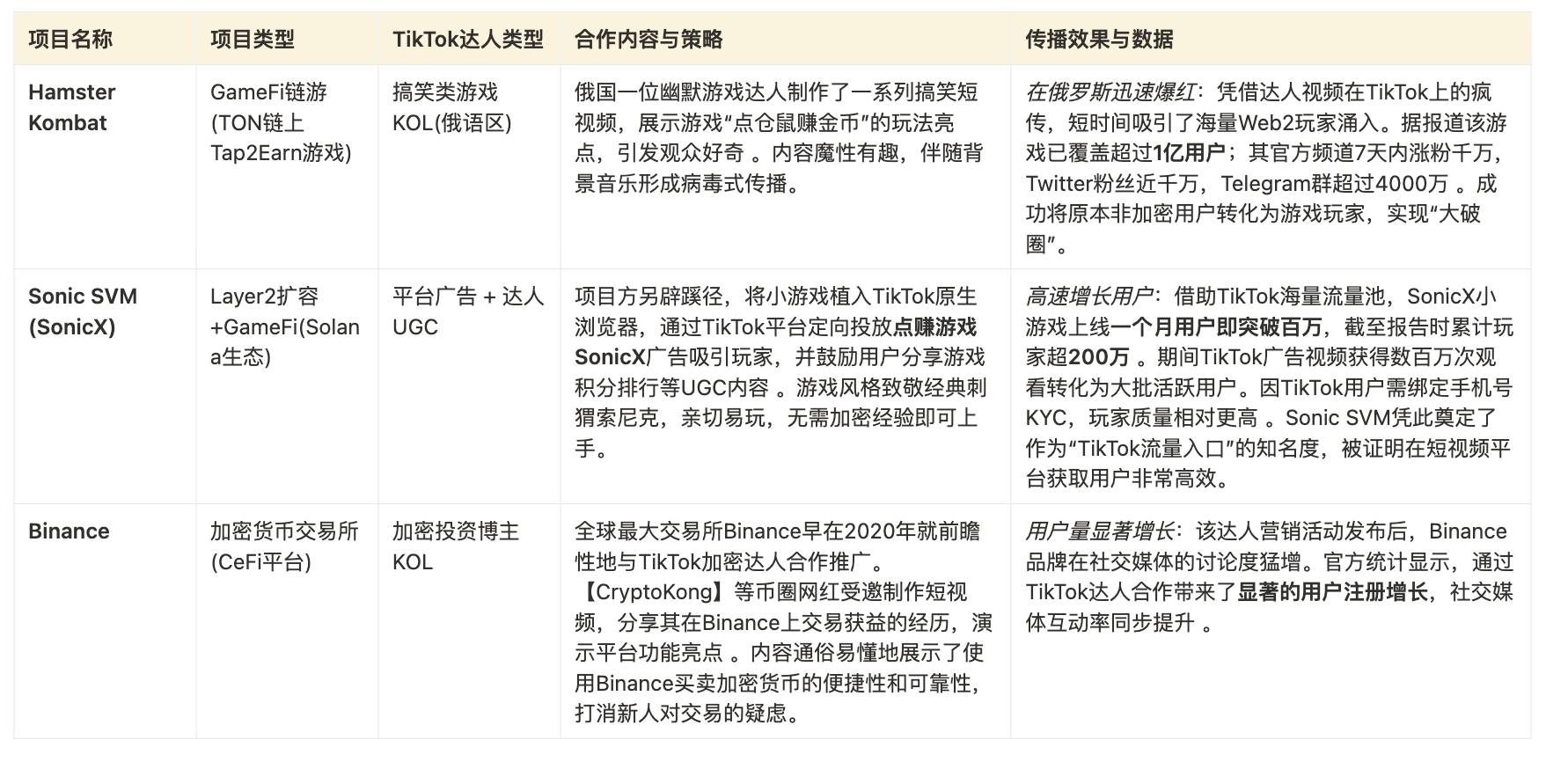
The above cases fully demonstrate the significant boosting effect of TikTok influencer marketing on Web3 projects:
Cross-Domain Reach: Hamster Kombat successfully combined local humor with blockchain gaming mechanics, reaching a large number of ordinary users who previously did not play crypto games, achieving over a billion exposures in a short time. Sonic SVM proved that short video platforms can become a new entry point for blockchain applications to acquire users, with user levels unimaginable in the traditional crypto sphere.
Winning Content Strategy: Several projects focused on using stories and challenges for dimensional dissemination. From humorous videos and classic IP nostalgia to everyday scene recreations, each content point is close to public interests rather than high-level technical preaching. This strategy lowers the cognitive barrier for Web2 users, encouraging them to spontaneously participate in discussions and trials.
Impressive Data Feedback: Whether it’s the surge in Binance users or the spike in downloads for payment apps, these hard metrics demonstrate the actual conversion effects brought by influencer marketing. The interaction data on TikTok (views, likes, comments) also far exceeds that of typical non-influencer content. For example, a spontaneous challenge by Dogecoin on TikTok led to a 20% price surge within a week, with related topic videos accumulating millions of views—though it was a community-driven action, it also reflected TikTok's astonishing "sales" capability and public appeal.
Additionally, there are cases like Coinbase achieving user surges through influencer promotions in 2021, and Polkadot investing heavily in KOL promotions in the first half of 2024, each with its gains and losses. Successful cases indicate that well-planned influencer collaborations can bring substantial returns to Web3 projects; conversely, improper investments (such as blindly throwing budgets at ineffective KOLs) may lead to wasted efforts or even community skepticism. Therefore, strategies should be prioritized to replicate the aforementioned successes.
IV. Strategic Recommendations
Based on the above analysis, we summarize several recommendations for formulating effective TikTok influencer collaboration strategies:
1. Define Goals and Budget
First, determine the main purpose of this influencer marketing—whether it is to increase brand awareness, promote user engagement, or directly drive new conversions. Different goals correspond to different content focuses and KPI settings. Once the goals are clear, a budget plan should be established. It is advisable to allocate the budget reasonably based on the project stage and marketing intensity, rather than solely pursuing top influencers. Large KOLs may have high quotes but do not necessarily bring proportional returns; consider combination placements.
2. Precisely Select Influencers and Build Relationships
As previously detailed, selecting influencers should prioritize fit and engagement rate rather than just traffic. Initial exploratory collaborations can validate the effectiveness of influencers before deepening long-term relationships. Additionally, establishing good communication with influencers is crucial—respecting their creative style and clarifying the collaboration process and rights (such as whether the project party is allowed to reuse influencer content).
3. Content Creativity and Rhythm Control
Lowering barriers and highlighting scenarios: For novice users, try to avoid stiff technical jargon.
Creating topics and interactions: Design suspense or challenges to guide audience participation in comments. For example, initiate a poll/Q&A interaction, "Would you accept 10% of your salary in Bitcoin?" to encourage viewers to express their opinions and increase algorithm recommendation weight.
Grasp the golden 3 seconds of the video: TikTok videos are scrolled through quickly, and the content in the first 3 seconds determines retention. Influencers should present a hook (an exaggerated result, a surprising twist, or an explosive visual) right at the beginning to grab attention, then elaborate on the project’s selling points. Conclude with a clear call to action (CTA), such as directing viewers to click on the profile link or use the project’s exclusive discount code.
Timing and frequency of posts: Choose posting times based on the target audience's online hours. In terms of frequency, during the promotional period, focus efforts on launching a series of videos intensively over one or two weeks to create a trend; during regular times, maintain a certain update frequency to keep the audience engaged. A "preheat-explosion-afterglow" rhythm can also be adopted: during the preheat phase, release a small amount of content to test the waters; during the explosion phase, have multiple influencers create topics; and follow up with a small amount of content to consolidate and deepen brand impressions.
4. Secondary Dissemination and Cross-Platform Operations
Do not limit the influence of TikTok influencers to the TikTok platform itself. Secondary utilization of content materials and cross-platform dissemination can greatly extend the marketing half-life.
Official account retweets: The project’s official TikTok account should promptly retweet high-quality content published by influencers to its own account and @mention the influencers to show appreciation. This not only enriches the official account's content but also conveys a signal of collaboration with influencers to fans, increasing credibility.
Synchronizing to platforms like Twitter: Appropriately edit the videos created by influencers and publish them on the project's Twitter, Instagram, YouTube, and other social media accounts to cover users on different platforms. Note: Obtain the influencer's authorization before cross-platform publishing and indicate the source as agreed.
Building a community: Users attracted by the influencer effect should be retained and converted into members of the project’s own community. For example, at the end of the influencer's video or in the comments, guide users to join the official Discord/Telegram to receive airdrop benefits or participate in activities on Twitter. This way, the temporary TikTok traffic peak can be transformed into long-term community assets.
5. Data Monitoring and Optimization
Establish clear KPIs and monitor effects in real-time to dynamically adjust strategies. Trackable data includes: the number of views, likes, and comments for each influencer's content, the number of clicks on project links or invitation codes, the number of new registered users, retention rates, and even conversion payment rates.
In summary, formulating TikTok influencer collaboration strategies requires "choosing the right people, having the right conversations, spending the right money, and summarizing diligently." It is essential to leverage the creativity and influence of influencers while also having scientific planning and review. Only in this way can one stand out in the crowded ocean of content and effectively convey Web3 project information to a vast number of Web2 users.
Conclusion
TikTok influencer marketing has opened a fast track for Web3 projects to reach mainstream users. Through the bridge role of influencers, obscure blockchain concepts are translated into popular language, and once "niche" Web3 applications can gain exposure on a platform with hundreds of millions of users. By correctly selecting suitable types of influencers, adopting creatively diverse collaboration forms, and supporting them with scientific strategic planning and data-driven optimization, Web3 projects have the opportunity to achieve "breaking the circle"—successfully converting Web2 or non-crypto users into fresh blood in the Web3 world. As the crypto industry seeks incremental users, effectively utilizing TikTok influencers will undoubtedly become the key to market expansion.
In the rapidly changing social media era, embracing new channels and effectively utilizing new-generation creators is essential to transforming complex technological revolutions into vibrant trends of public participation. This is both a challenge for Web3 project marketing and an unprecedented opportunity. Let us look forward to more successful cases in the future, witnessing TikTok influencers helping Web3 move towards the mainstream.
7 | Comprehensive Growth Strategies for Web3 Projects
Introduction
In the Web3 field, users are not traditional advertising "audiences," but highly fluid individuals who are sensitive to incentives, emotional, and expressive. Over the past few years, Web3 projects have continuously iterated on user growth and dissemination strategies, resulting in many effective and innovative approaches. As a marketing agency focused on Web3, Cube Labs has accumulated a wealth of frontline practical experience through collaborations with multiple GameFi, DeFi, and Layer1 projects. We have distilled this experience into a structured methodology, breaking it down into six key dimensions, forming this series of content, hoping to provide practical strategy references for more project teams: first, content rhythm and indicator system for Twitter operations; second, how the task system filters real users, potential paying users, and on-chain users; third, community ecosystem building: structured active mechanisms combining Discord and Telegram; fourth, PR collaboration strategies: timing, path building, and amplification of endorsements; fifth, advertising platform strategies for Web2: differentiated traffic generation for GameFi/DeFi/Layer1 projects; sixth, expansion to external platforms: TikTok influencer marketing. Below, we will introduce the research focus, strategic thinking, and practical value of each dimension to help everyone quickly grasp the comprehensive strategy for Web3 growth.
1. Twitter Operations: Content Rhythm and Indicator System
Twitter plays a cognitive shaping, behavior guiding, and participation motivation stimulating role in Web3 marketing. Twitter operations are not about "high-frequency tweeting equals growth," but rather about stimulating user behavior through carefully designed content rhythms. Based on marketing experience from multiple Web3 projects, we have summarized a "three-stage rhythm × layered content × behavior guidance" operational model, emphasizing that each tweet should serve as a designed trigger for user behavior. From the perspective of content rhythm, it can be divided into three stages:
Preliminary Phase: Targeting potential users who are still unaware, using emotional, situational, or topical content to attract attention and create an atmosphere of "what happened" rather than directly discussing rewards.
Promotion Phase: Targeting interested followers, pushing incentive-based, clearly defined content to ignite interest with project benefits, and including a clear action CTA (such as "Join the test").
Retention Phase: Addressing users who have participated and begun to express themselves, focusing on value-driven, resonant, and UGC (user-generated content), encouraging users to share images, ask questions, and express opinions, allowing core users to continuously produce content.
In addition, it is essential to focus on the five core indicators of Twitter operations: follower growth, engagement rate and participation, comment quality and community reputation, event conversion and user retention, and brand consistency. For example, follower growth reflects the sustainability of voice; engagement rate measures community activity; comment quality assesses community atmosphere; event conversion focuses on whether followers convert to community or on-chain users due to tweet interactions; brand consistency builds trust through unified visual copy. These indicators help the operations team quantify effects, monitor risks, and optimize using data tools (such as Twitterscore).
2. Task System Filtering: Real Users, Paying Users, and On-Chain Users
The core of designing Web3 task marketing (Campaign) lies in filtering out real and valuable users. Among a large number of participants, there are inevitably fake accounts and opportunists, so a funnel-style task system needs to be constructed. Based on practical experience, we summarize three major strategies:
Guiding Structure: Use a progressively layered task path, gradually filtering from easy to difficult. Each stage sets appropriate thresholds, allowing a large number of users to enter from the starting point and filtering core users layer by layer. For example, the first layer only requires retweeting to attract a broad audience; the middle layer requires filling out a questionnaire or uploading screenshots to raise participation thresholds; the high layer requires on-chain operations (Mint, staking, etc.) to ensure that only users who genuinely use the product remain.
Anti-Fraud Mechanism: Identify user authenticity through identity + behavior dual verification. For social verification, bind Twitter/X accounts and record retweet behavior; for on-chain verification, analyze wallet interaction frequency and asset holdings; in high-value stages, KYC verification (such as Galxe Passport, World ID) can be introduced; simultaneously, use address pattern recognition and IP verification technologies to filter out bulk cheating accounts.
Layered Filtering: Continue to evaluate the value of users who complete all basic tasks. Analyze user behavior patterns in the Campaign (active contribution vs. speculative arbitrage); real users often interact on Discord, participate in AMAs, etc., while pure opportunists only perform minimal operations. Additionally, on-chain asset data (such as mainstream token balances, high-value NFT holdings) can be used to assess purchasing power, and users' social influence (number of invited friends, tweet retweet volume, etc.) can be leveraged to identify key disseminators. Through multiple checkpoints and intelligent data analysis, ultimately retain real users, potential paying users, and active on-chain users.
3. Community Ecosystem Building: Efficient Strategies for Discord and Telegram
Taking the example of building a GameFi community ecosystem, we advocate the community operation concept of "induction + triggering + retention." Discord and Telegram are the two core platforms for Web3 community operations, each serving different roles:
Dual Platform Parallel Strategy: Most projects use Telegram for rapid traffic generation and announcement pushing, while Discord is responsible for in-depth discussions and task handling. Telegram excels in immediacy and broad coverage, suitable for pushing project information, answering questions, and arranging airdrop interactions; Discord can create multi-level channels, role permissions, and bot tools, suitable for establishing multi-themed discussion areas and long-term retention mechanisms.
Community Structure and Identity Layering: In Discord, it is recommended to clearly divide channels (such as announcements, rules, discussions, technical support, FAQs, holder zones, etc.) and set different roles and access permissions for token holders, VIPs, newcomers, etc., using bots (such as Collab.Land) to automatically verify token holder identities. In Telegram, a main chat group and an announcement channel where only administrators can speak can be established, helping newcomers grow through pinned group rules/FAQs. Although Telegram cannot achieve the fine layering of Discord, verification Q&A or verification code mechanisms can be used to reduce bot risks. Regardless of the platform, clear structure and layering enhance user experience and promote orderly information flow.
Retention and Daily Activity: Emphasizing the first-day experience and continuous output. For newcomers, "breaking the ice" can be achieved through Discord's welcome page and beginner's guide (for example, setting prompts like "Please introduce yourself first"), which can increase the speaking rate on the first day and subsequently improve one-week retention. In terms of daily activity, diverse activities and topics can be planned, utilizing incentives such as points, badges, and leaderboards to encourage user participation and creation, promoting UGC output and community culture formation. We recommend converting the core users that have been retained into brand ambassadors (such as "Community Star" selections and social media promotions), creating a positive feedback loop. Through guiding mechanisms, activity topics, and structured operations, the community gradually evolves from a simple discussion space into a strategic base for project growth and deep user engagement.
4. PR Collaboration Strategy: Timing and Amplifying Endorsements
Cooperation announcement tweets are not routine tasks but carefully planned communication opportunities. When releasing collaboration news, the project team must "hit the right rhythm": the timing should be during the user attention window, and the content should provoke community participation and convert into trust endorsements. The key purpose of collaboration tweets is to create credible signals + stimulate participation motivation. Even if the collaboration itself is limited in substance, as long as the topic is packaged appropriately, it can create a positive impression of "the project is actively developing and being accepted by the mainstream ecosystem," triggering user FOMO and increasing discussion heat.
In terms of content composition and format, we provide practical template references and suggestions: tweet titles should use eye-catching tones and emojis (e.g., "🚀 Collaboration Announcement: We have formed a strategic partnership with **!"), creating excitement; then summarize the highlights of the collaboration in one sentence (emphasizing what new experiences the integration brings), and attach visual materials such as both parties' logos to enhance recognition. The body should clearly state the call to action (such as tag challenges, retweet lotteries, etc.) and control the number of tags to avoid information redundancy. It is especially important to maintain *consistent coordination between the tweet images and brand style to prevent a sense of "not looking like a collaboration."* Through such design, the collaboration tweet not only conveys project information but also becomes a bridge to engage users and build trust.
5. Web2 Advertising Strategy: Differentiation for GameFi/DeFi/Layer1
After comparing the advertising strategies of major Web2 platforms, we focus on developing differentiated strategies based on project types (GameFi, DeFi, Layer1) and target audiences. The main conclusions are as follows:
GameFi Projects: Essentially a composite product of "entertainment content + asset incentives," requiring high visual and gameplay standards. Advertising materials should showcase gameplay demonstration videos, player earnings screenshots, and cool NFT prop images to attract both players and crypto users. Advertising channels can include TikTok (using challenge videos and quick gameplay demonstrations to spark viral spread), Facebook/Instagram (fine-tuned targeting based on gaming interests), Twitter (advertising to GameFi KOL followers to enhance discussion), and YouTube/Twitch (collaborating with gaming streamers for promotion). Additionally, strategies such as multi-point advertising + KOL collaboration + community task loops should be employed, while paying attention to creative ideas (TikTok) and advertising policies (Meta strictly reviews crypto content).
DeFi Projects: The core selling points are product trust and professionalism. Audiences are sensitive to yield models and security, so advertising materials should focus on graphic and textual yield structure explanations, educational short videos, and audit report screenshots/security endorsements. Advertising channels lean towards Twitter (targeting finance/crypto KOL fans), Google Ads (using search keywords to attract precise traffic), Facebook/Instagram (spreading educational content and remarketing to recapture lost users), and on-chain advertising networks (targeted advertising based on wallet tags). The core strategy is "content first, then dissemination + education at the core + security endorsements + remarketing," and it is strongly recommended to link with community activities (such as Telegram AMAs, Discord tests) to extend the conversion path. When monitoring, the goal should be to "deepen user understanding/join the community" rather than simply focusing on click rates and immediate ROI.
Layer1 Projects: The advertising goal is to shape technical authority and ecological resonance, with short-term ROI being secondary. Common materials include mainnet launch announcements, financing or milestone news, technical white paper interpretations, partner endorsement images, TPS performance data, and hackathon information. Advertising channels primarily focus on Twitter (a gathering place for developers and core crypto users), promoting hot topics (with budgets reaching hundreds of thousands of dollars), LinkedIn (showcasing enterprise-level technical visions and collaboration opportunities), Facebook/Instagram (advertising technical introduction videos and community traffic), supplemented by industry offline conferences or city landmark advertisements to strengthen brand voice. The key points are technical credibility + brand endorsements + ecological calls, customizing content for different audiences: speaking technicalities to developers, discussing collaborations with investors, and addressing incentives for end users.
In summary, different categories of Web3 projects need to match suitable materials and channels, designing a complete loop from exposure to interest to participation.
6. External Channel Expansion: TikTok Influencer Marketing
Finally, we explore strategies for attracting users through influencer marketing on the new TikTok channel. As one of the hottest short video platforms, TikTok opens the door for Web3 projects to non-crypto users. Choosing the right type of influencer and collaboration format is key. Specifically:
Influencer Types and Selection: Choose TikTok creators from different fields based on the project’s tone. Common types of influencers include: crypto education (deeply engaged in blockchain content, helping to establish the project's credibility in the crypto community), gaming/anime (targeting GameFi projects to attract gaming enthusiasts), comedy/entertainment (creating viral humorous content that dramatizes obscure concepts to reach a broader non-crypto audience), and finance/investment (targeting users interested in investment, explaining how the project can enhance financial value through vivid scenarios). When selecting, do not focus solely on follower count; also consider follower demographics, engagement rates, and content creativity. Influencers are generally categorized into micro (≤10,000 followers), mid-tier (10,000–1 million), and large (over 1 million): mid-tier influencers often have higher engagement rates and stronger relatability; top influencers have broad coverage but relatively lower conversion rates per post. Project teams should prioritize selecting vertical influencers that closely match the target audience and share similar values.
Collaboration Formats: TikTok influencer marketing offers diverse and innovative combinations. Common models include: paid short video promotions (the project team pays influencers to create promotional videos that introduce project features or user experiences, directly gaining significant exposure); product placements and reviews (the project team provides NFTs, game props, wallet apps, etc., for influencers to try, with influencers soft-embedding or unboxing in live streams or daily videos to enhance credibility); topic challenges (Hashtag Challenge) (official or influencer-initiated themed challenges with project tags, guiding users to imitate and create, generating UGC trends, such as Sweatcoin's walking challenge); AMA and live interaction (joint live Q&A sessions with influencers, where the influencer's trust enhances fan participation and addresses new user questions in real-time); airdrop benefit introductions (influencers explain how to claim project airdrops, attaching invitation links to attract new users through free benefits, significantly increasing registration conversion); influencer personal experience/narrative videos (recording the influencer's experience with the project from a narrative perspective, enhancing immersion, such as gaming influencers continuously documenting their insights while playing a certain blockchain game, gradually deepening fans' interest and trust in the game). Additionally, there are innovative plays like brand takeovers, giveaway contests, and collaborative influencer shoots. The key is to cleverly integrate project selling points into the content while giving influencers creative freedom, making the promotion appear natural and sincere, thereby enhancing trust.
Strategy Combinations and Recommendations: It is recommended that project teams combine various formats based on the project stage to create a tiered dissemination effect. For example, before the project launch, influencers can first release suspenseful short clips to build momentum, then initiate a challenge to spark discussions, and finally consolidate conversions through live AMAs. Successful cases show that selecting humorous influencers in niche markets can generate massive dissemination—such as the GameFi project Hamster Kombat inviting gaming comedy influencers to create a series of short videos, attracting over 100 million new players in a short time and significantly increasing official social media followers, achieving "explosive breaking the circle." This demonstrates that TikTok influencer marketing provides an efficient means for Web3 projects to reach non-crypto users, but it requires matching target audiences, creative driving, and data-driven fine operations to truly land.
Summary and Future Outlook
In summary, we have revealed key strategies for the growth of Web3 projects from different angles: Twitter should design content rhythms and quantify indicators, task systems should build hierarchical task funnels to filter high-value users, community operations should utilize a structured approach on both Discord and Telegram, PR should release rhythmic collaborative content to amplify endorsement effects, advertising strategies should develop differentiated materials and channel strategies for GameFi/DeFi/Layer1 types, and external channels should reach more Web2 users through TikTok influencer marketing. These strategic systems complement each other, collectively constructing a complete loop for Web3 projects from user acquisition, activation to retention. In the future, as the ecosystem matures and data tools become widespread, Web3 growth operations will become more refined and data-driven. Project teams need to continuously optimize content and activity design, strengthen cross-platform collaboration, and effectively utilize AI and on-chain data analysis to iteratively adjust strategies in real-time, gaining broader attention and higher-quality user groups for their projects. By implementing the aforementioned methodologies, Web3 projects can not only stand out in homogeneous competition but also cultivate truly loyal community supporters, achieving long-term sustainable growth.
About Cube Labs
Cube Labs is a global marketing agency deeply engaged in the Web3 field, long-term serving crypto projects such as GameFi, DeFi, and Layer1. We focus on user growth, content dissemination, community operations, and upper-level strategies, having helped multiple projects achieve breakthroughs from cold starts to scaled expansions.
📩 Want to collaborate with us? Feel free to contact:
👉 X: https://x.com/cubelabs_web3
👉 TG: https://t.me/SunnyZ_Web3 https://t.me/caylachen
👉 Or send an email to: contact@cubelabs.com
免责声明:本文章仅代表作者个人观点,不代表本平台的立场和观点。本文章仅供信息分享,不构成对任何人的任何投资建议。用户与作者之间的任何争议,与本平台无关。如网页中刊载的文章或图片涉及侵权,请提供相关的权利证明和身份证明发送邮件到support@aicoin.com,本平台相关工作人员将会进行核查。




